Exploring BATMAN and SPEED: Routing Protocols for Ad-hoc Networks
VerifiedAdded on 2023/06/12
|27
|2239
|314
Report
AI Summary
This report provides an overview of mobile ad-hoc networks (MANETs) and delves into two prominent routing protocols: Better Approach To Mobile Ad-Hoc Networking (B.A.T.M.A.N.) and SPEED, a real-time routing protocol for wireless sensor networks. It begins by introducing wireless networking concepts, highlighting the characteristics and advantages of ad-hoc networks, and then focuses on the MESH topology. The report details the B.A.T.M.A.N protocol, its algorithm, and its advantages over Optimized Link State Protocol (OLSR). Furthermore, it explores real-time sensor networks, their applications, constraints, and the importance of MAC and routing protocols. The SPEED protocol and its variations (MM SPEED, FT SPEED, EE SPEED) are discussed in detail, along with their evaluation and comparison. The report concludes by emphasizing the suitability of B.A.T.M.A.N for ad-hoc networks and SPEED (particularly MMSPEED) for real-time wireless networking.
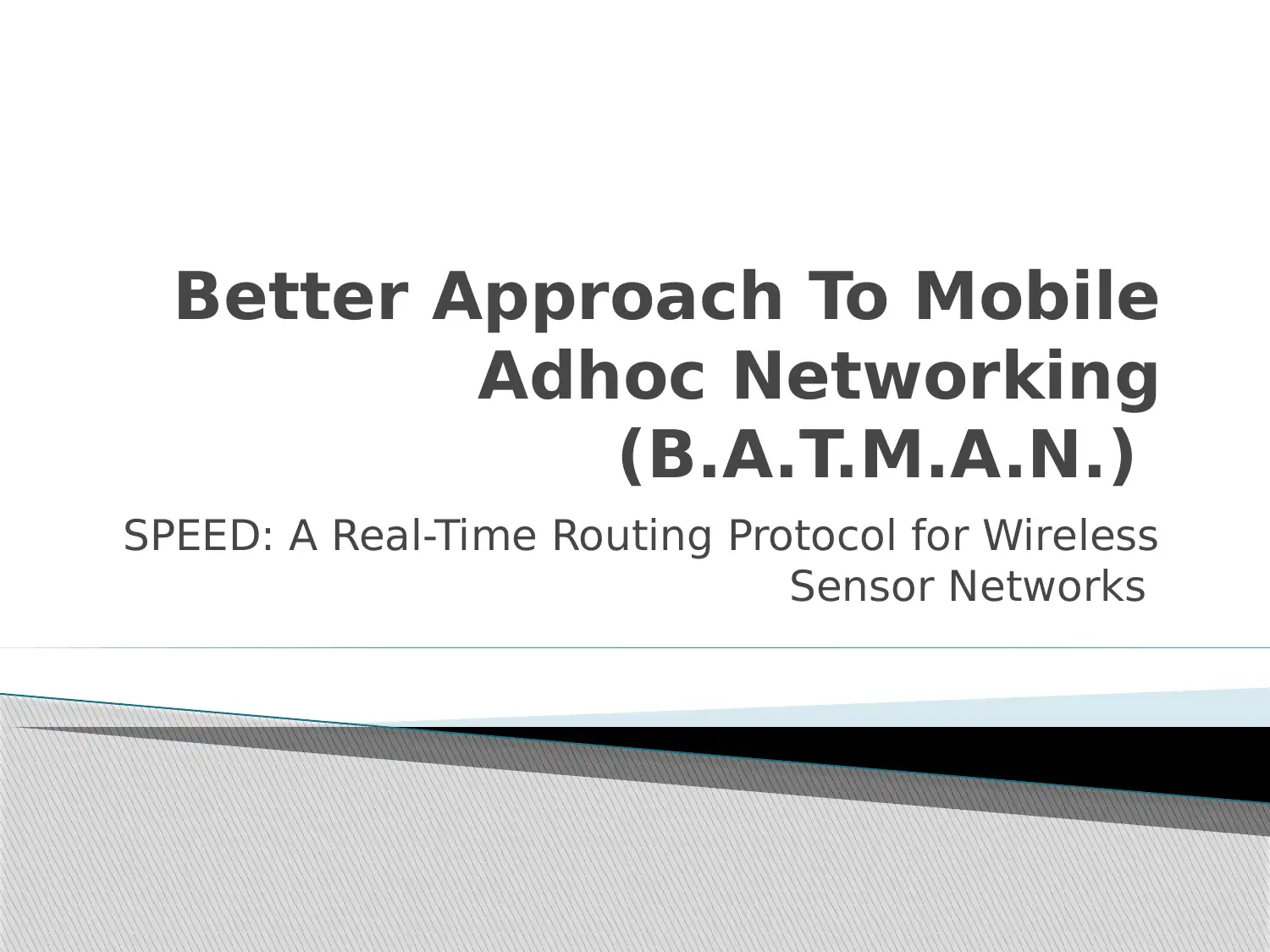
Better Approach To Mobile
Adhoc Networking
(B.A.T.M.A.N.)
SPEED: A Real-Time Routing Protocol for Wireless
Sensor Networks
Adhoc Networking
(B.A.T.M.A.N.)
SPEED: A Real-Time Routing Protocol for Wireless
Sensor Networks
Secure Best Marks with AI Grader
Need help grading? Try our AI Grader for instant feedback on your assignments.
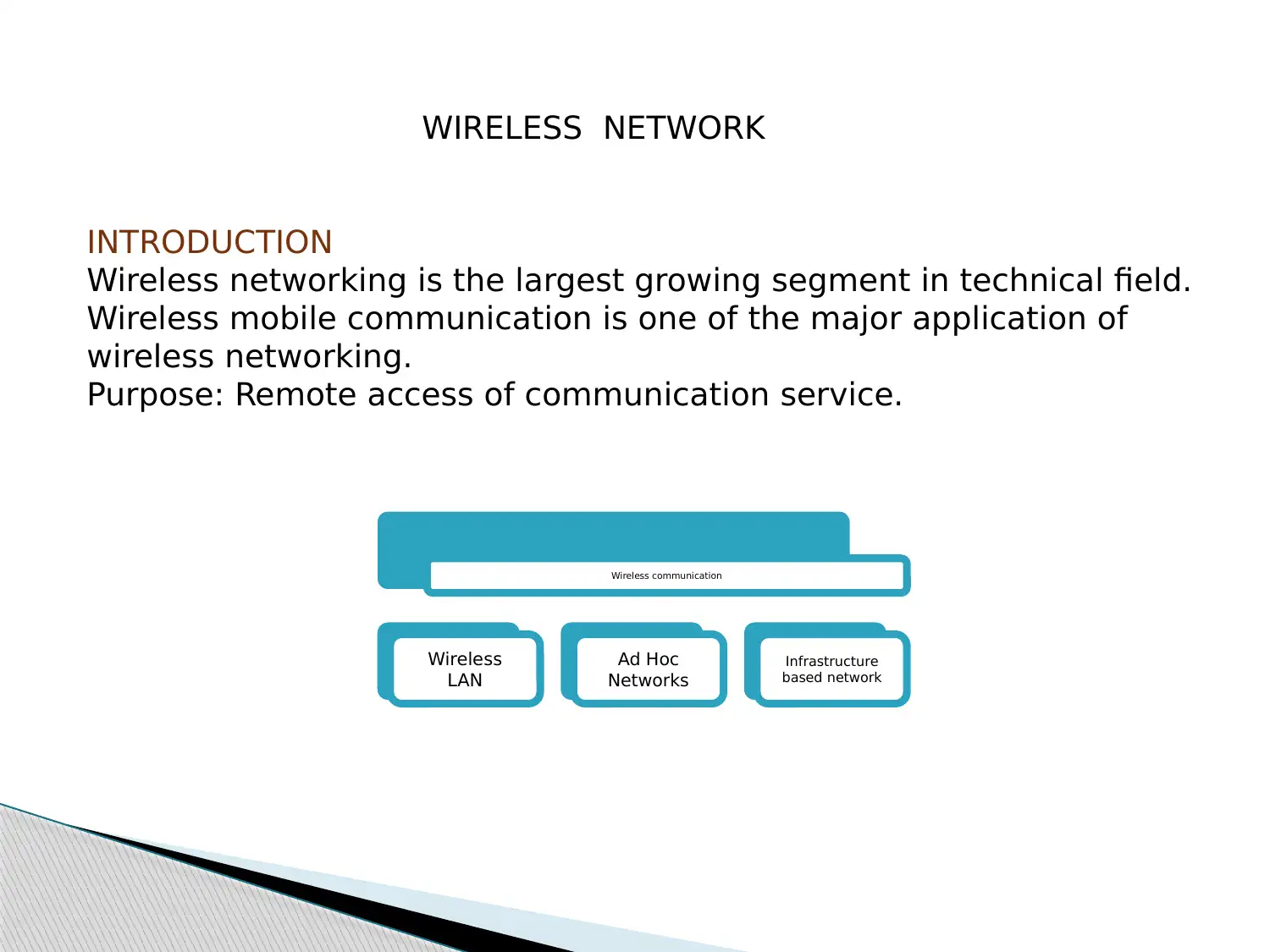
WIRELESS NETWORK
INTRODUCTION
Wireless networking is the largest growing segment in technical field.
Wireless mobile communication is one of the major application of
wireless networking.
Purpose: Remote access of communication service.
Wireless communication
Wireless
LAN
Ad Hoc
Networks
Infrastructure
based network
INTRODUCTION
Wireless networking is the largest growing segment in technical field.
Wireless mobile communication is one of the major application of
wireless networking.
Purpose: Remote access of communication service.
Wireless communication
Wireless
LAN
Ad Hoc
Networks
Infrastructure
based network
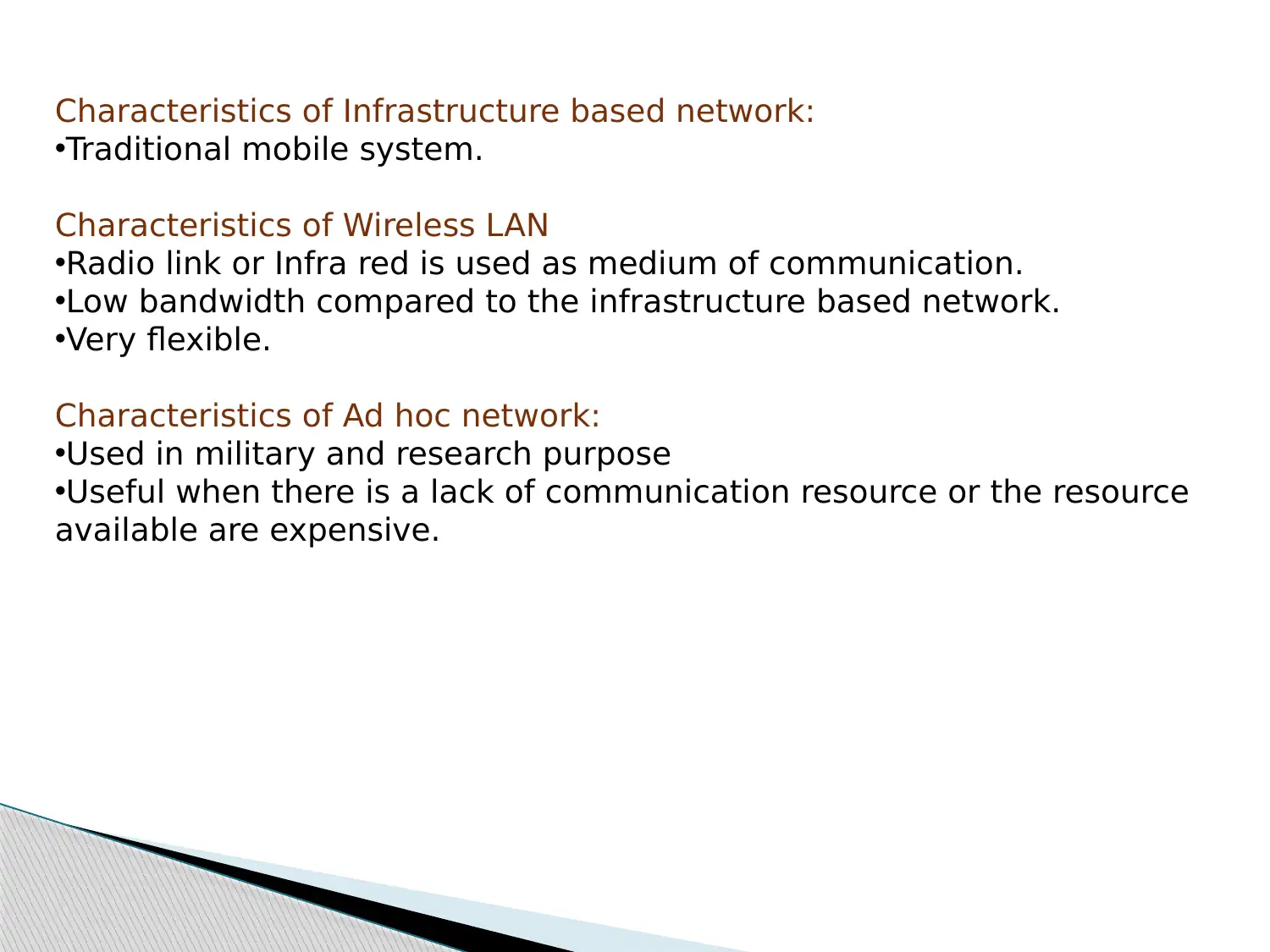
Characteristics of Infrastructure based network:
•Traditional mobile system.
Characteristics of Wireless LAN
•Radio link or Infra red is used as medium of communication.
•Low bandwidth compared to the infrastructure based network.
•Very flexible.
Characteristics of Ad hoc network:
•Used in military and research purpose
•Useful when there is a lack of communication resource or the resource
available are expensive.
•Traditional mobile system.
Characteristics of Wireless LAN
•Radio link or Infra red is used as medium of communication.
•Low bandwidth compared to the infrastructure based network.
•Very flexible.
Characteristics of Ad hoc network:
•Used in military and research purpose
•Useful when there is a lack of communication resource or the resource
available are expensive.
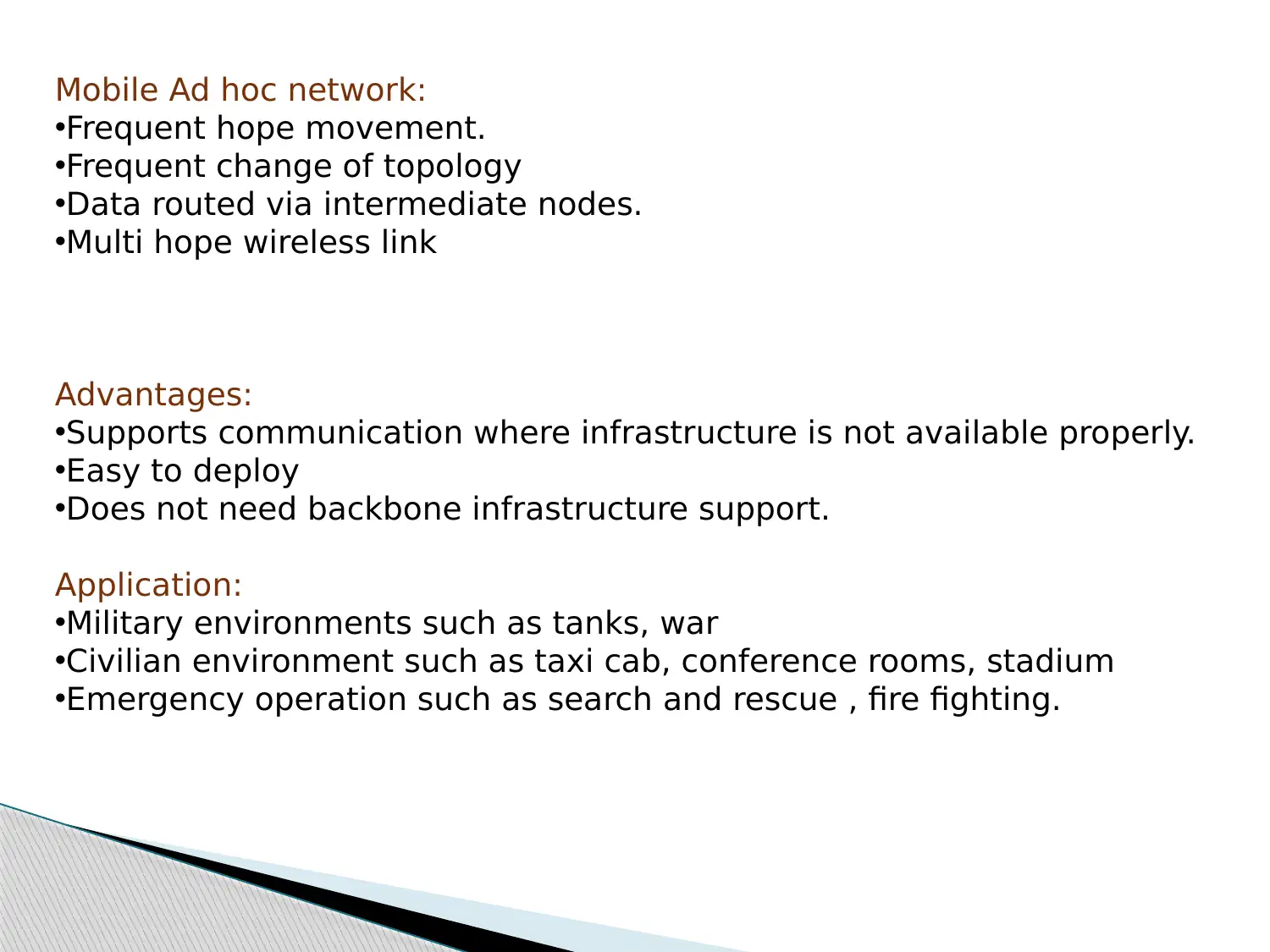
Mobile Ad hoc network:
•Frequent hope movement.
•Frequent change of topology
•Data routed via intermediate nodes.
•Multi hope wireless link
Advantages:
•Supports communication where infrastructure is not available properly.
•Easy to deploy
•Does not need backbone infrastructure support.
Application:
•Military environments such as tanks, war
•Civilian environment such as taxi cab, conference rooms, stadium
•Emergency operation such as search and rescue , fire fighting.
•Frequent hope movement.
•Frequent change of topology
•Data routed via intermediate nodes.
•Multi hope wireless link
Advantages:
•Supports communication where infrastructure is not available properly.
•Easy to deploy
•Does not need backbone infrastructure support.
Application:
•Military environments such as tanks, war
•Civilian environment such as taxi cab, conference rooms, stadium
•Emergency operation such as search and rescue , fire fighting.
Secure Best Marks with AI Grader
Need help grading? Try our AI Grader for instant feedback on your assignments.
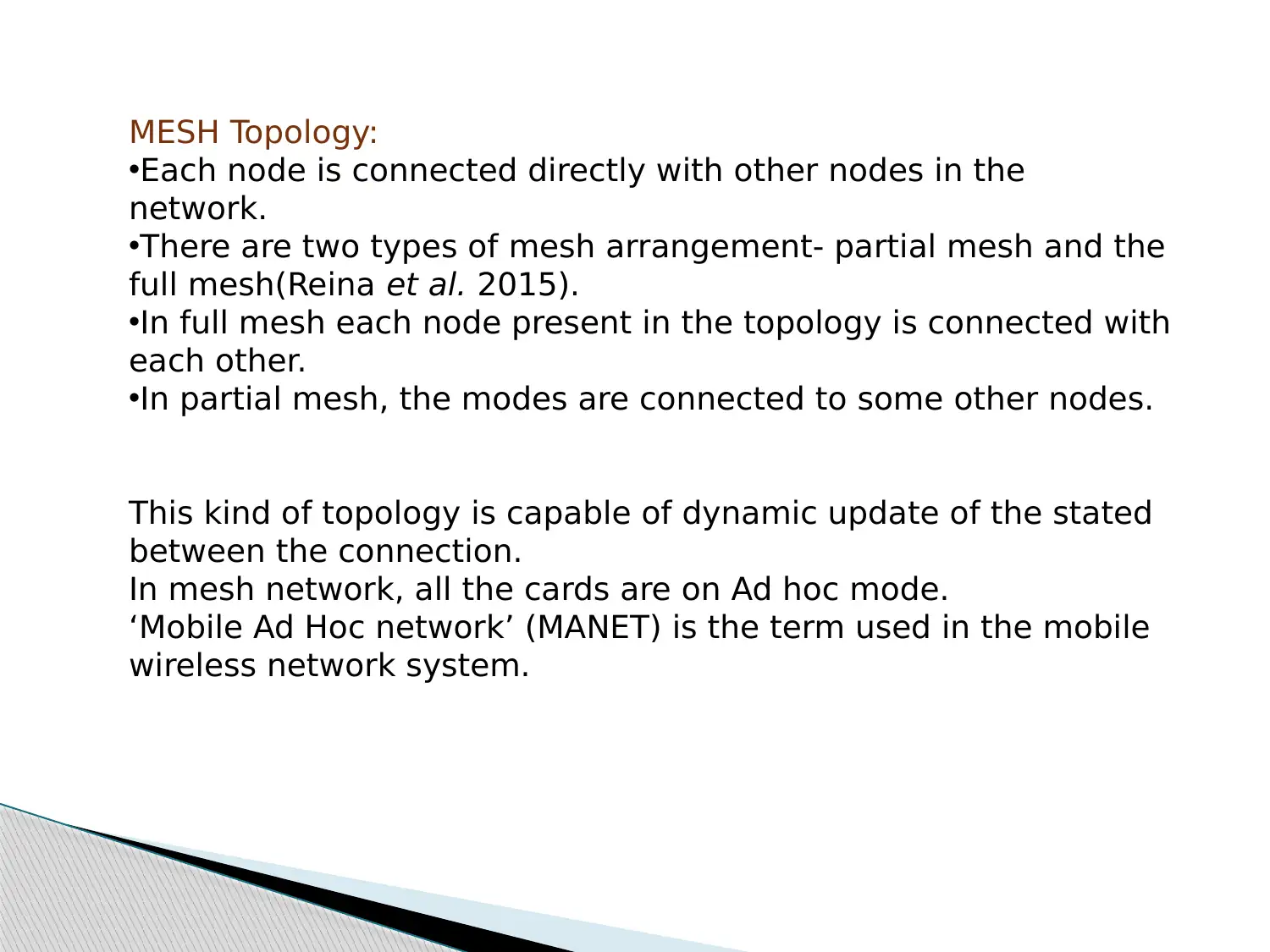
MESH Topology:
•Each node is connected directly with other nodes in the
network.
•There are two types of mesh arrangement- partial mesh and the
full mesh(Reina et al. 2015).
•In full mesh each node present in the topology is connected with
each other.
•In partial mesh, the modes are connected to some other nodes.
This kind of topology is capable of dynamic update of the stated
between the connection.
In mesh network, all the cards are on Ad hoc mode.
‘Mobile Ad Hoc network’ (MANET) is the term used in the mobile
wireless network system.
•Each node is connected directly with other nodes in the
network.
•There are two types of mesh arrangement- partial mesh and the
full mesh(Reina et al. 2015).
•In full mesh each node present in the topology is connected with
each other.
•In partial mesh, the modes are connected to some other nodes.
This kind of topology is capable of dynamic update of the stated
between the connection.
In mesh network, all the cards are on Ad hoc mode.
‘Mobile Ad Hoc network’ (MANET) is the term used in the mobile
wireless network system.
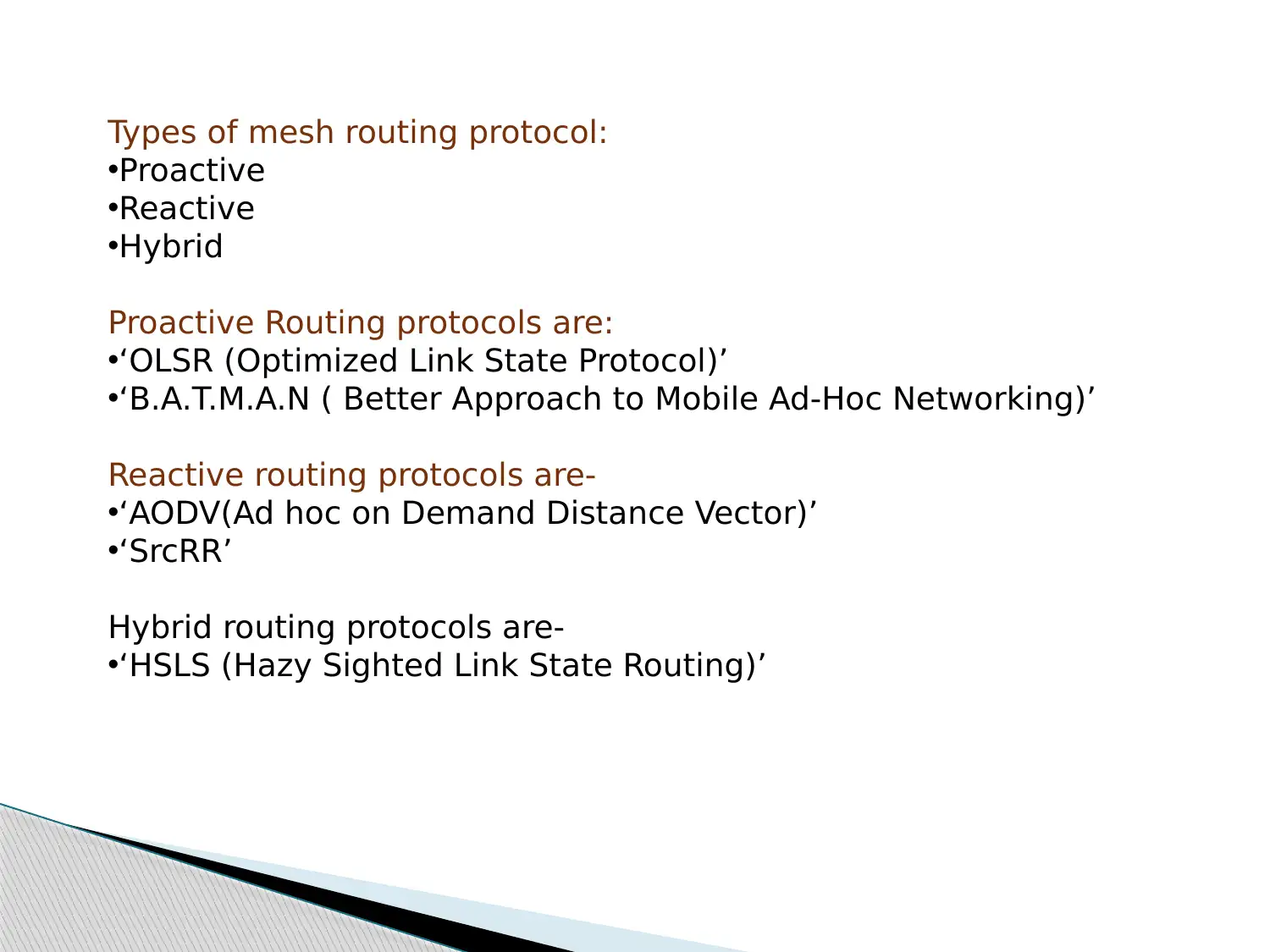
Types of mesh routing protocol:
•Proactive
•Reactive
•Hybrid
Proactive Routing protocols are:
•‘OLSR (Optimized Link State Protocol)’
•‘B.A.T.M.A.N ( Better Approach to Mobile Ad-Hoc Networking)’
Reactive routing protocols are-
•‘AODV(Ad hoc on Demand Distance Vector)’
•‘SrcRR’
Hybrid routing protocols are-
•‘HSLS (Hazy Sighted Link State Routing)’
•Proactive
•Reactive
•Hybrid
Proactive Routing protocols are:
•‘OLSR (Optimized Link State Protocol)’
•‘B.A.T.M.A.N ( Better Approach to Mobile Ad-Hoc Networking)’
Reactive routing protocols are-
•‘AODV(Ad hoc on Demand Distance Vector)’
•‘SrcRR’
Hybrid routing protocols are-
•‘HSLS (Hazy Sighted Link State Routing)’

Classes of Mobile Ad Hoc networking:
•Table driven
Example- B.A.T.M.A.N,OLSR
•Non-Table Driven
Goals:
•Determination of best paths by the nodes based on the controls of the
packet.
•Every node should have information about the entire network.
Specialty of B.A.T.M.A.N:
•The link quality is determined by the presence or absence of the control
packets.
•Table driven
Example- B.A.T.M.A.N,OLSR
•Non-Table Driven
Goals:
•Determination of best paths by the nodes based on the controls of the
packet.
•Every node should have information about the entire network.
Specialty of B.A.T.M.A.N:
•The link quality is determined by the presence or absence of the control
packets.
Paraphrase This Document
Need a fresh take? Get an instant paraphrase of this document with our AI Paraphraser
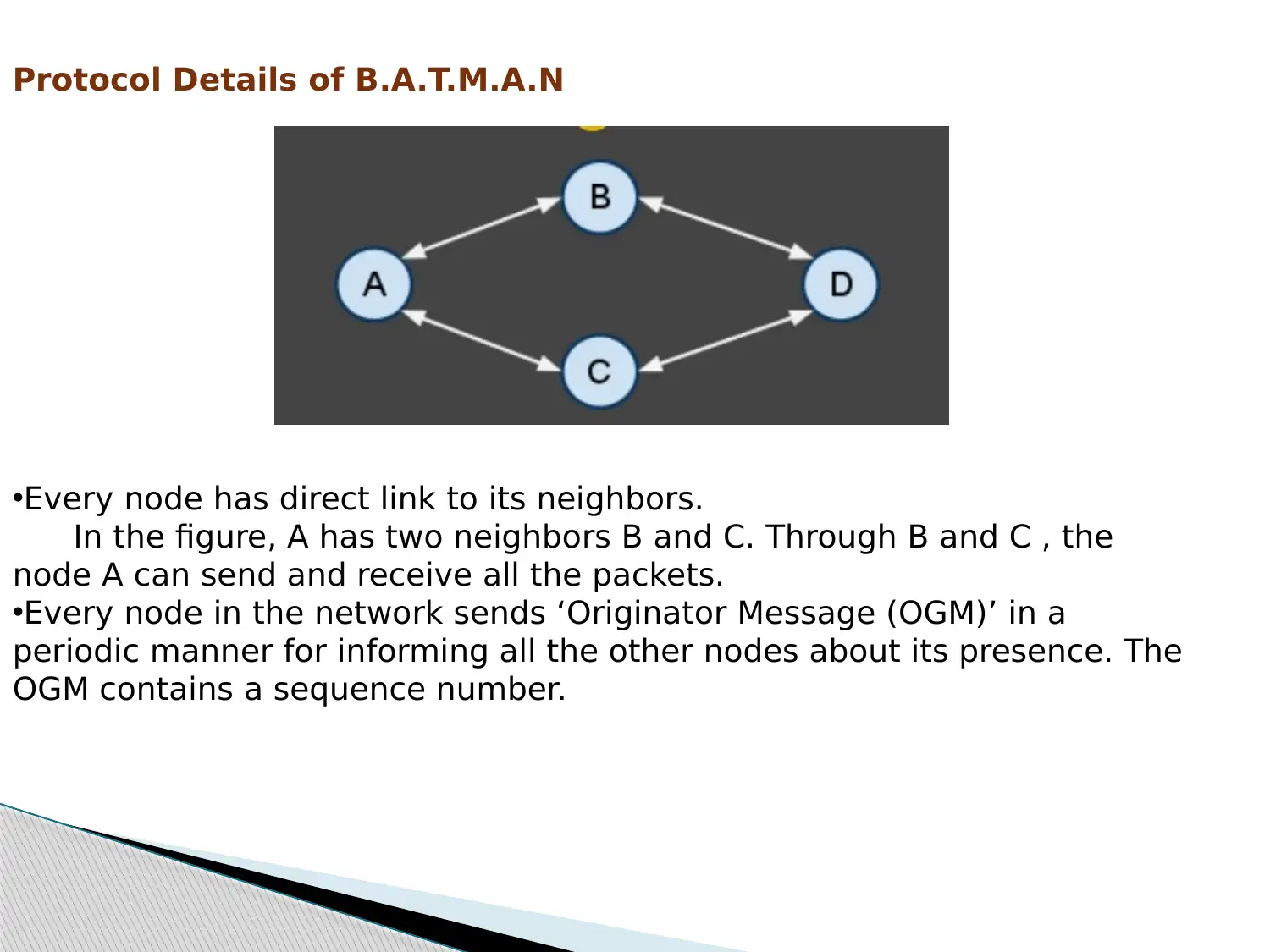
Protocol Details of B.A.T.M.A.N
•Every node has direct link to its neighbors.
In the figure, A has two neighbors B and C. Through B and C , the
node A can send and receive all the packets.
•Every node in the network sends ‘Originator Message (OGM)’ in a
periodic manner for informing all the other nodes about its presence. The
OGM contains a sequence number.
•Every node has direct link to its neighbors.
In the figure, A has two neighbors B and C. Through B and C , the
node A can send and receive all the packets.
•Every node in the network sends ‘Originator Message (OGM)’ in a
periodic manner for informing all the other nodes about its presence. The
OGM contains a sequence number.
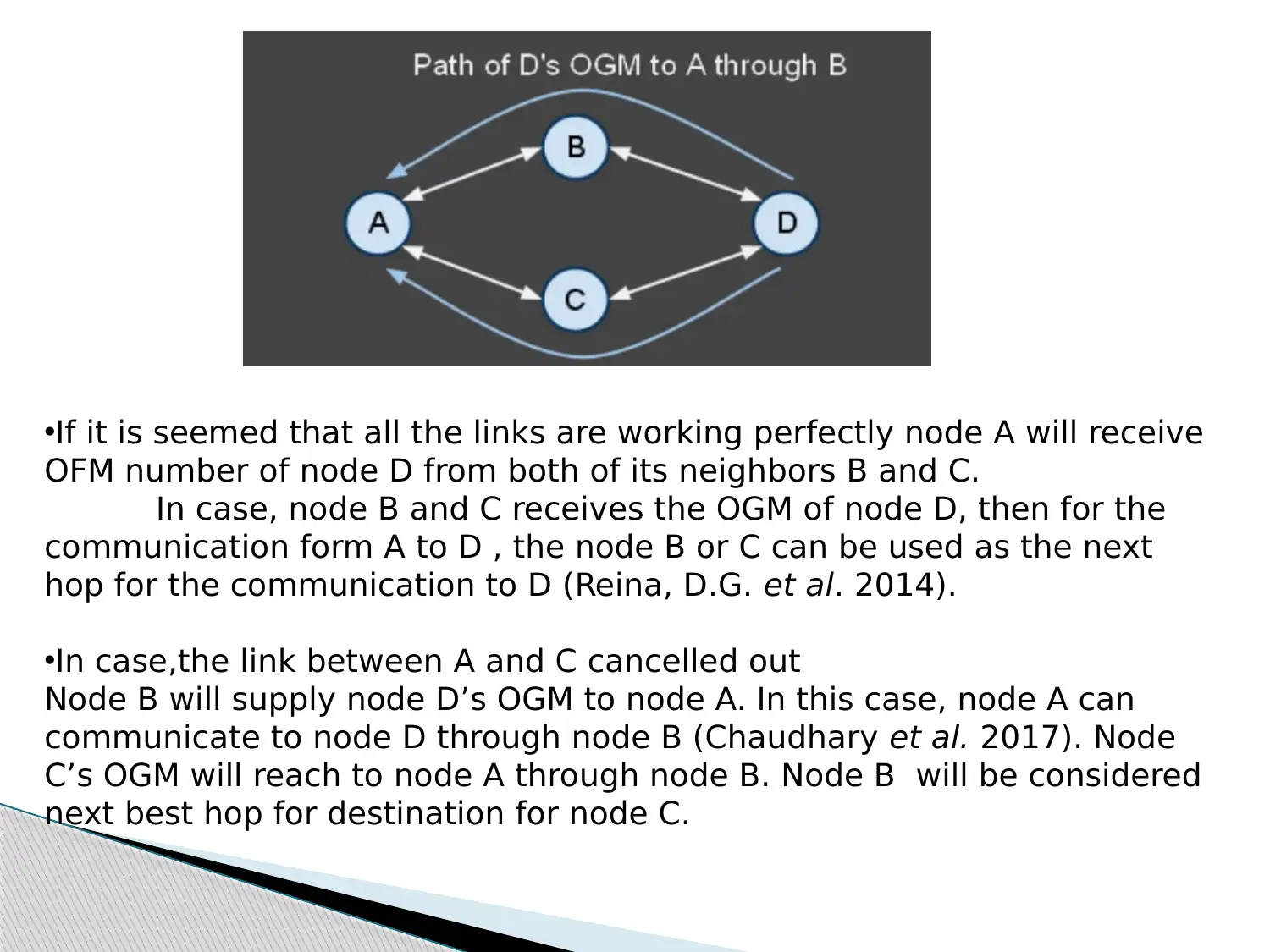
•If it is seemed that all the links are working perfectly node A will receive
OFM number of node D from both of its neighbors B and C.
In case, node B and C receives the OGM of node D, then for the
communication form A to D , the node B or C can be used as the next
hop for the communication to D (Reina, D.G. et al. 2014).
•In case,the link between A and C cancelled out
Node B will supply node D’s OGM to node A. In this case, node A can
communicate to node D through node B (Chaudhary et al. 2017). Node
C’s OGM will reach to node A through node B. Node B will be considered
next best hop for destination for node C.
OFM number of node D from both of its neighbors B and C.
In case, node B and C receives the OGM of node D, then for the
communication form A to D , the node B or C can be used as the next
hop for the communication to D (Reina, D.G. et al. 2014).
•In case,the link between A and C cancelled out
Node B will supply node D’s OGM to node A. In this case, node A can
communicate to node D through node B (Chaudhary et al. 2017). Node
C’s OGM will reach to node A through node B. Node B will be considered
next best hop for destination for node C.
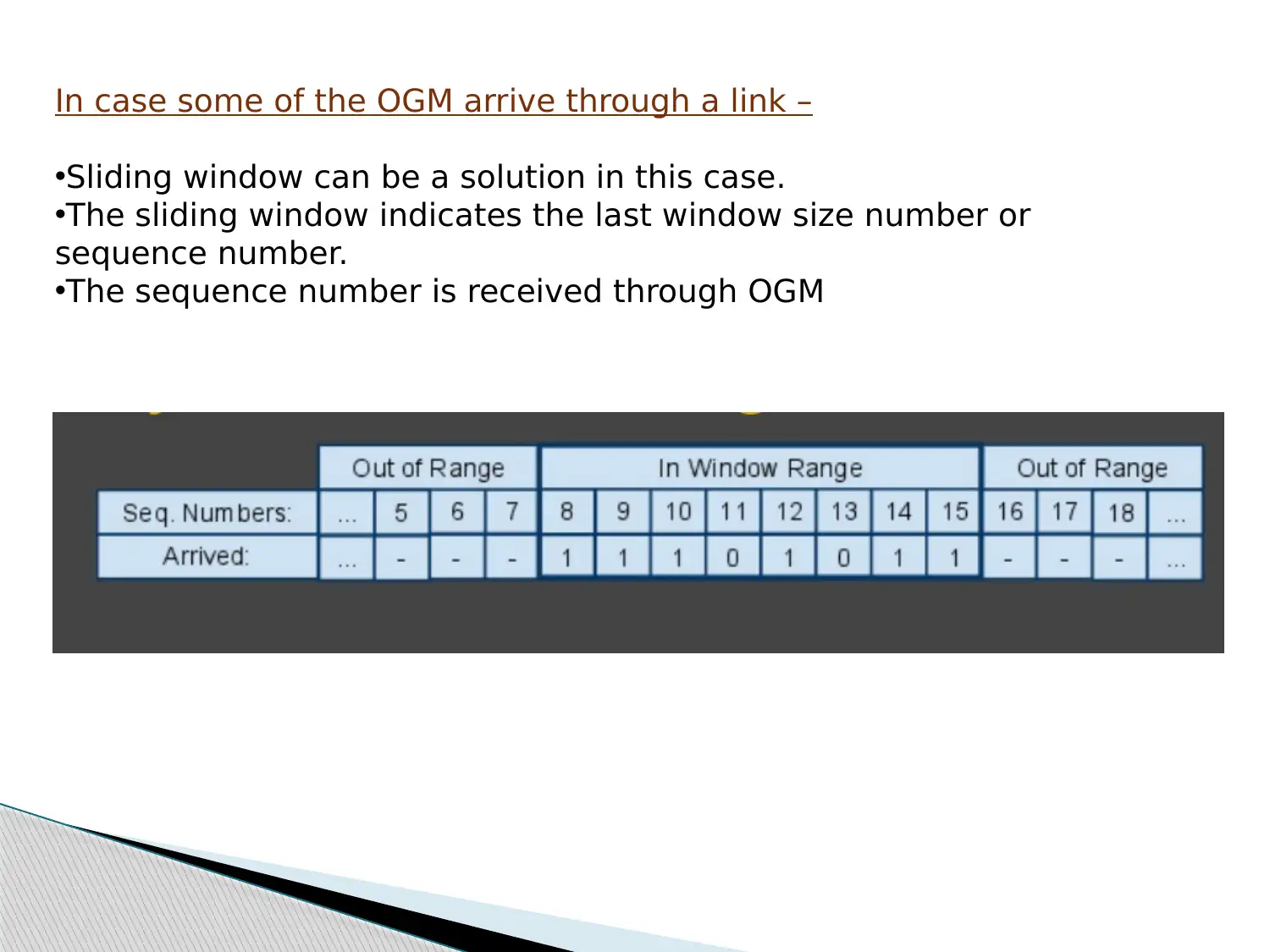
In case some of the OGM arrive through a link –
•Sliding window can be a solution in this case.
•The sliding window indicates the last window size number or
sequence number.
•The sequence number is received through OGM
•Sliding window can be a solution in this case.
•The sliding window indicates the last window size number or
sequence number.
•The sequence number is received through OGM
Secure Best Marks with AI Grader
Need help grading? Try our AI Grader for instant feedback on your assignments.
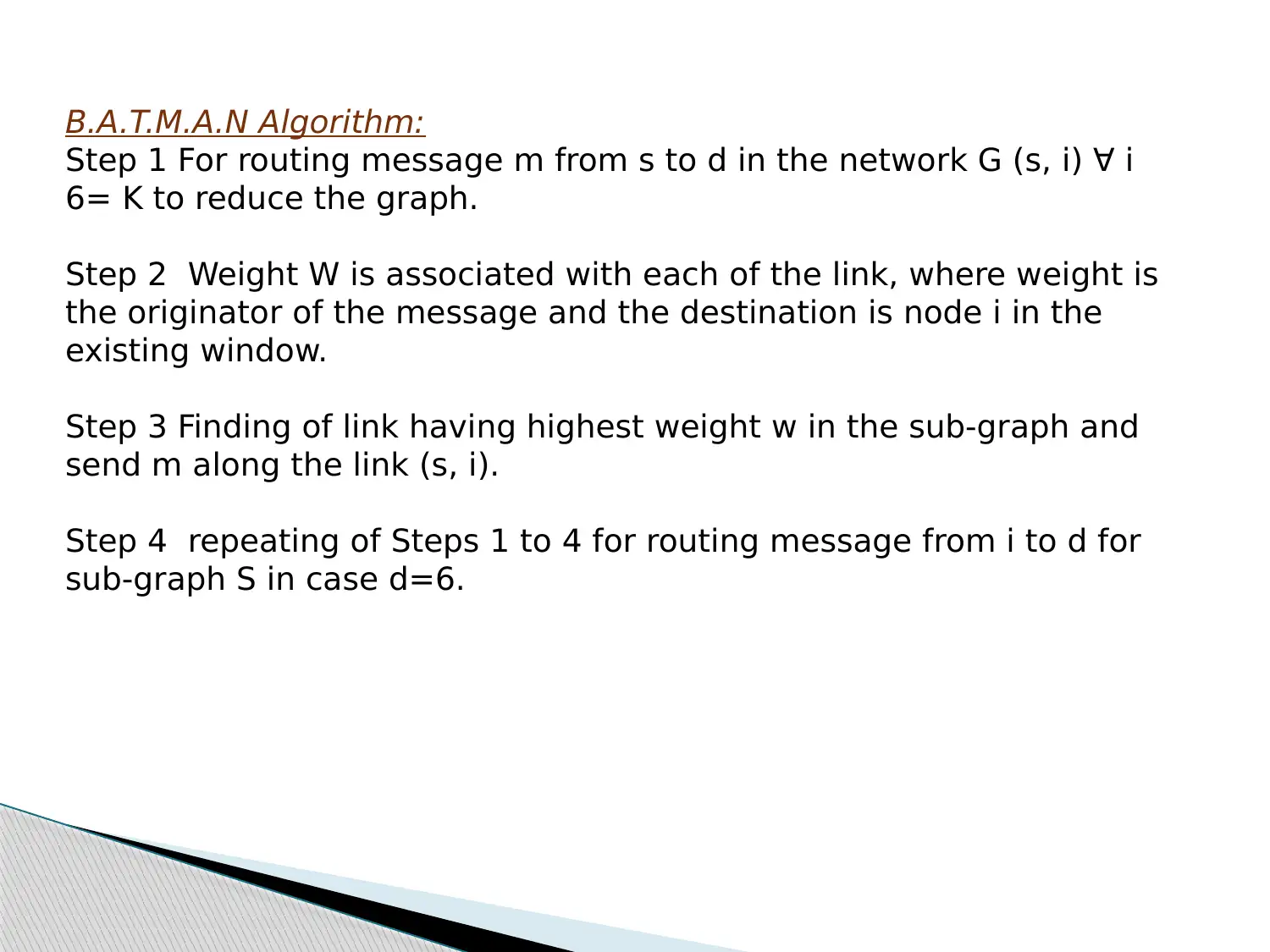
B.A.T.M.A.N Algorithm:
Step 1 For routing message m from s to d in the network G (s, i) ∀ i
6= K to reduce the graph.
Step 2 Weight W is associated with each of the link, where weight is
the originator of the message and the destination is node i in the
existing window.
Step 3 Finding of link having highest weight w in the sub-graph and
send m along the link (s, i).
Step 4 repeating of Steps 1 to 4 for routing message from i to d for
sub-graph S in case d=6.
Step 1 For routing message m from s to d in the network G (s, i) ∀ i
6= K to reduce the graph.
Step 2 Weight W is associated with each of the link, where weight is
the originator of the message and the destination is node i in the
existing window.
Step 3 Finding of link having highest weight w in the sub-graph and
send m along the link (s, i).
Step 4 repeating of Steps 1 to 4 for routing message from i to d for
sub-graph S in case d=6.
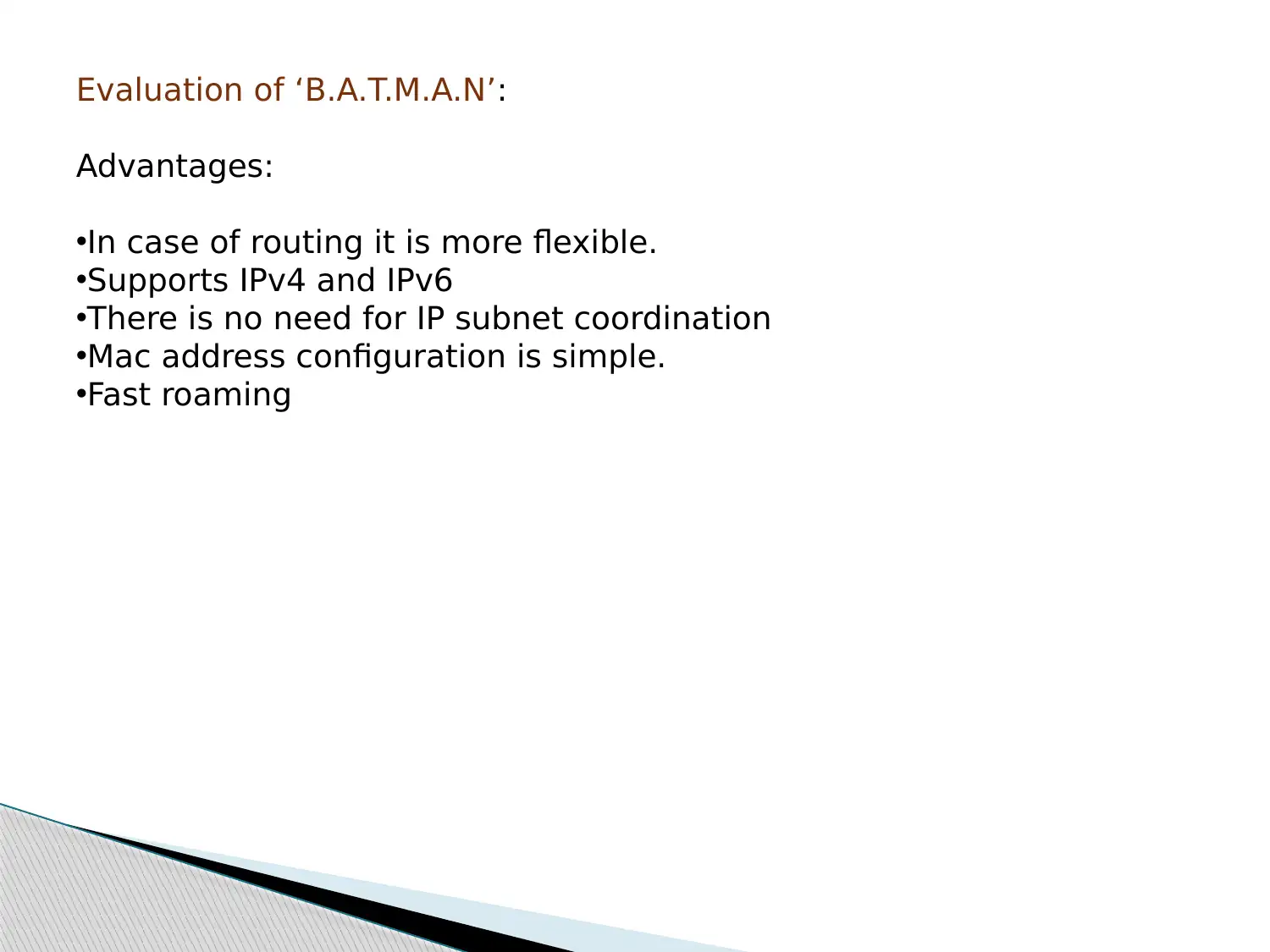
Evaluation of ‘B.A.T.M.A.N’:
Advantages:
•In case of routing it is more flexible.
•Supports IPv4 and IPv6
•There is no need for IP subnet coordination
•Mac address configuration is simple.
•Fast roaming
Advantages:
•In case of routing it is more flexible.
•Supports IPv4 and IPv6
•There is no need for IP subnet coordination
•Mac address configuration is simple.
•Fast roaming
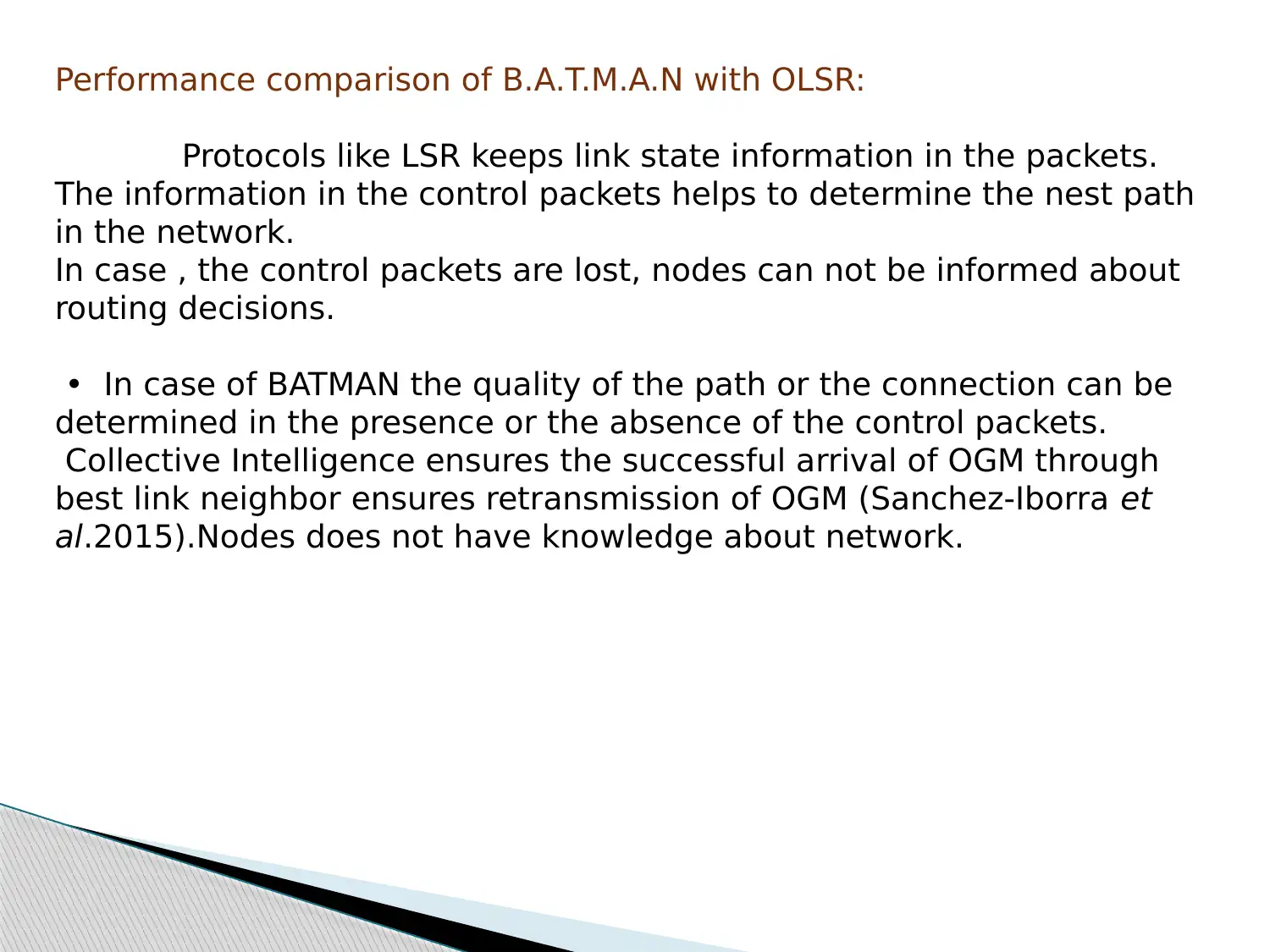
Performance comparison of B.A.T.M.A.N with OLSR:
Protocols like LSR keeps link state information in the packets.
The information in the control packets helps to determine the nest path
in the network.
In case , the control packets are lost, nodes can not be informed about
routing decisions.
• In case of BATMAN the quality of the path or the connection can be
determined in the presence or the absence of the control packets.
Collective Intelligence ensures the successful arrival of OGM through
best link neighbor ensures retransmission of OGM (Sanchez-Iborra et
al.2015).Nodes does not have knowledge about network.
Protocols like LSR keeps link state information in the packets.
The information in the control packets helps to determine the nest path
in the network.
In case , the control packets are lost, nodes can not be informed about
routing decisions.
• In case of BATMAN the quality of the path or the connection can be
determined in the presence or the absence of the control packets.
Collective Intelligence ensures the successful arrival of OGM through
best link neighbor ensures retransmission of OGM (Sanchez-Iborra et
al.2015).Nodes does not have knowledge about network.
Paraphrase This Document
Need a fresh take? Get an instant paraphrase of this document with our AI Paraphraser
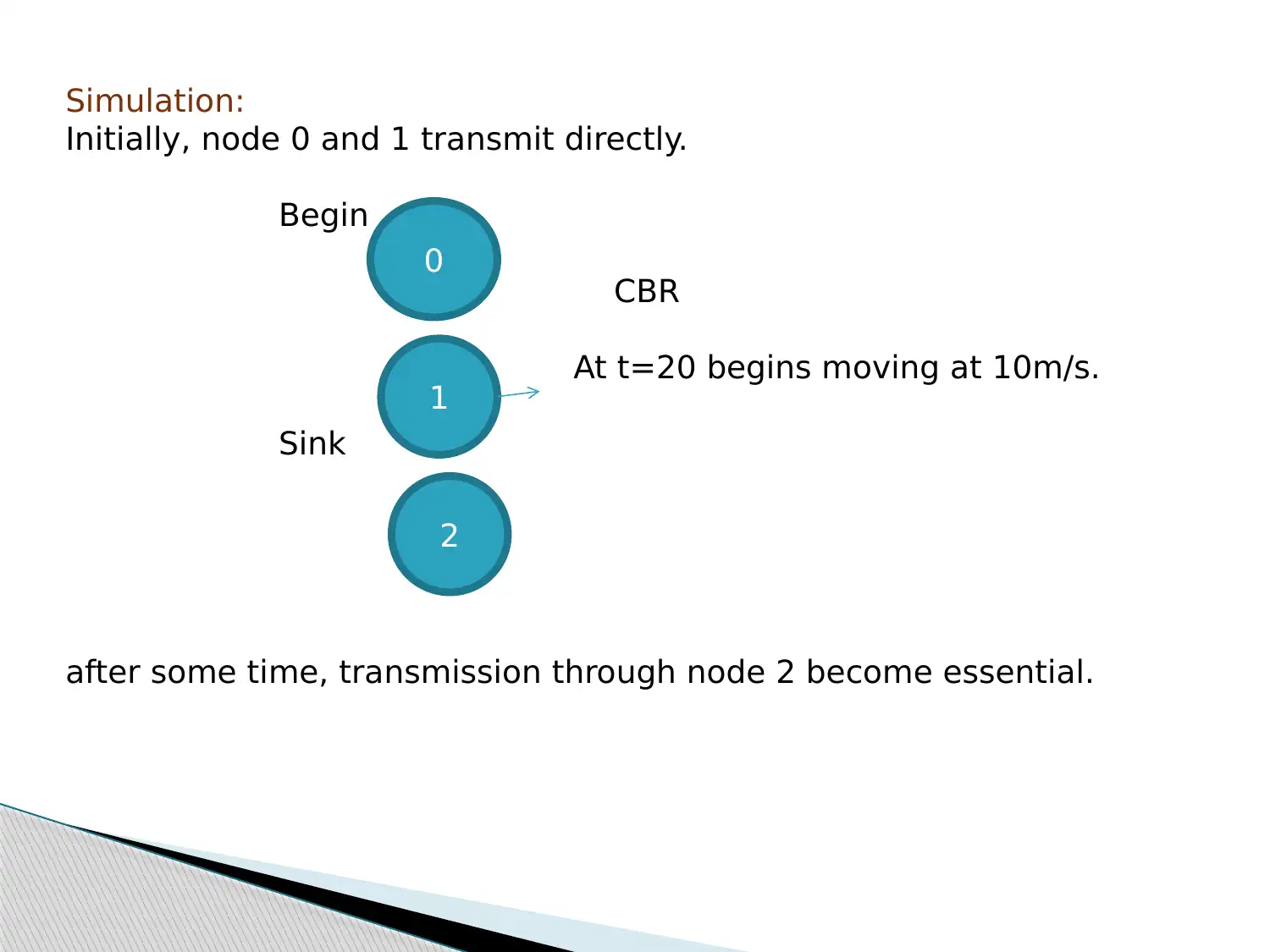
Simulation:
Initially, node 0 and 1 transmit directly.
Begin
CBR
At t=20 begins moving at 10m/s.
Sink
after some time, transmission through node 2 become essential.
1
2
0
Initially, node 0 and 1 transmit directly.
Begin
CBR
At t=20 begins moving at 10m/s.
Sink
after some time, transmission through node 2 become essential.
1
2
0
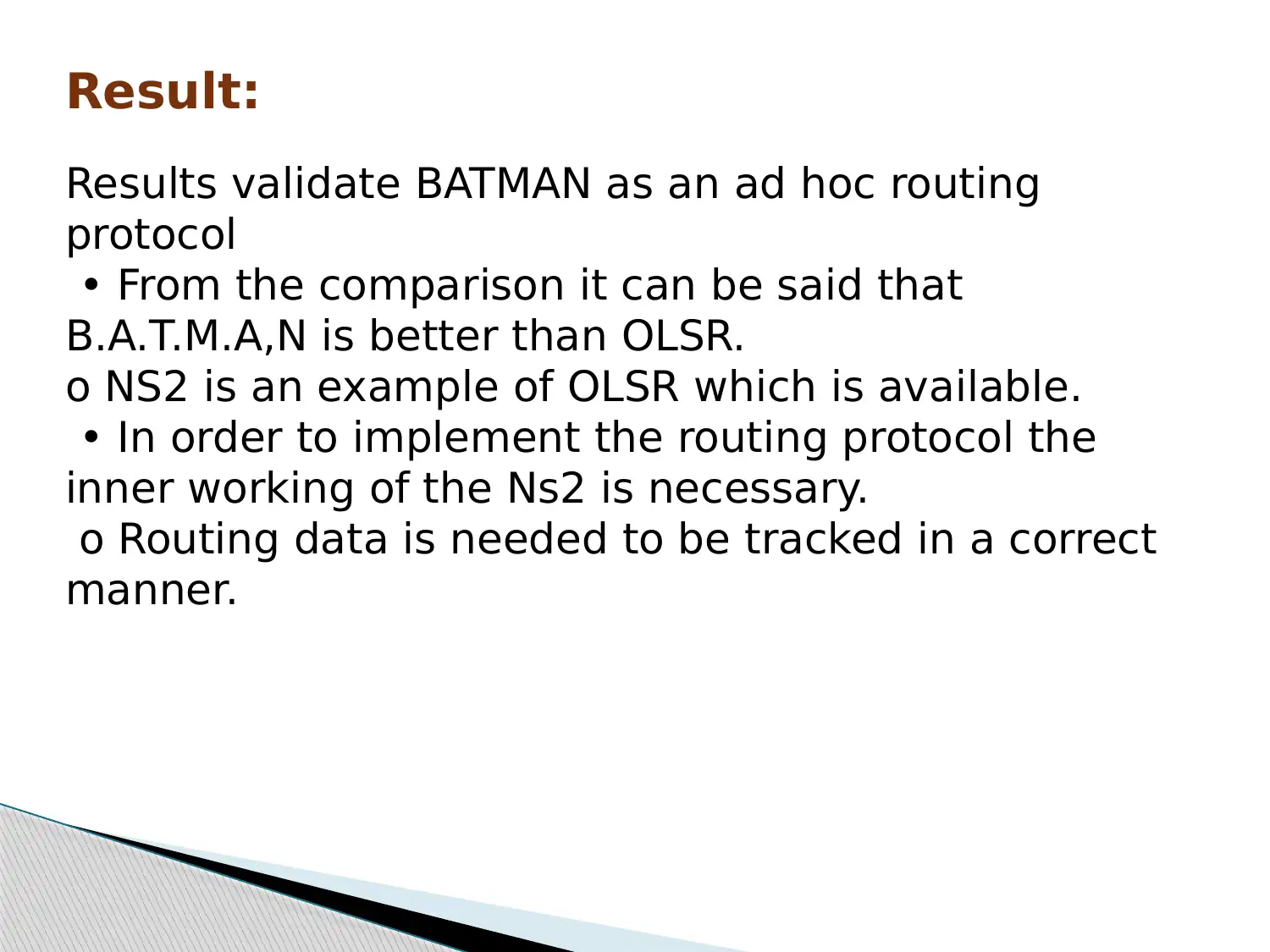
Result:
Results validate BATMAN as an ad hoc routing
protocol
• From the comparison it can be said that
B.A.T.M.A,N is better than OLSR.
o NS2 is an example of OLSR which is available.
• In order to implement the routing protocol the
inner working of the Ns2 is necessary.
o Routing data is needed to be tracked in a correct
manner.
Results validate BATMAN as an ad hoc routing
protocol
• From the comparison it can be said that
B.A.T.M.A,N is better than OLSR.
o NS2 is an example of OLSR which is available.
• In order to implement the routing protocol the
inner working of the Ns2 is necessary.
o Routing data is needed to be tracked in a correct
manner.
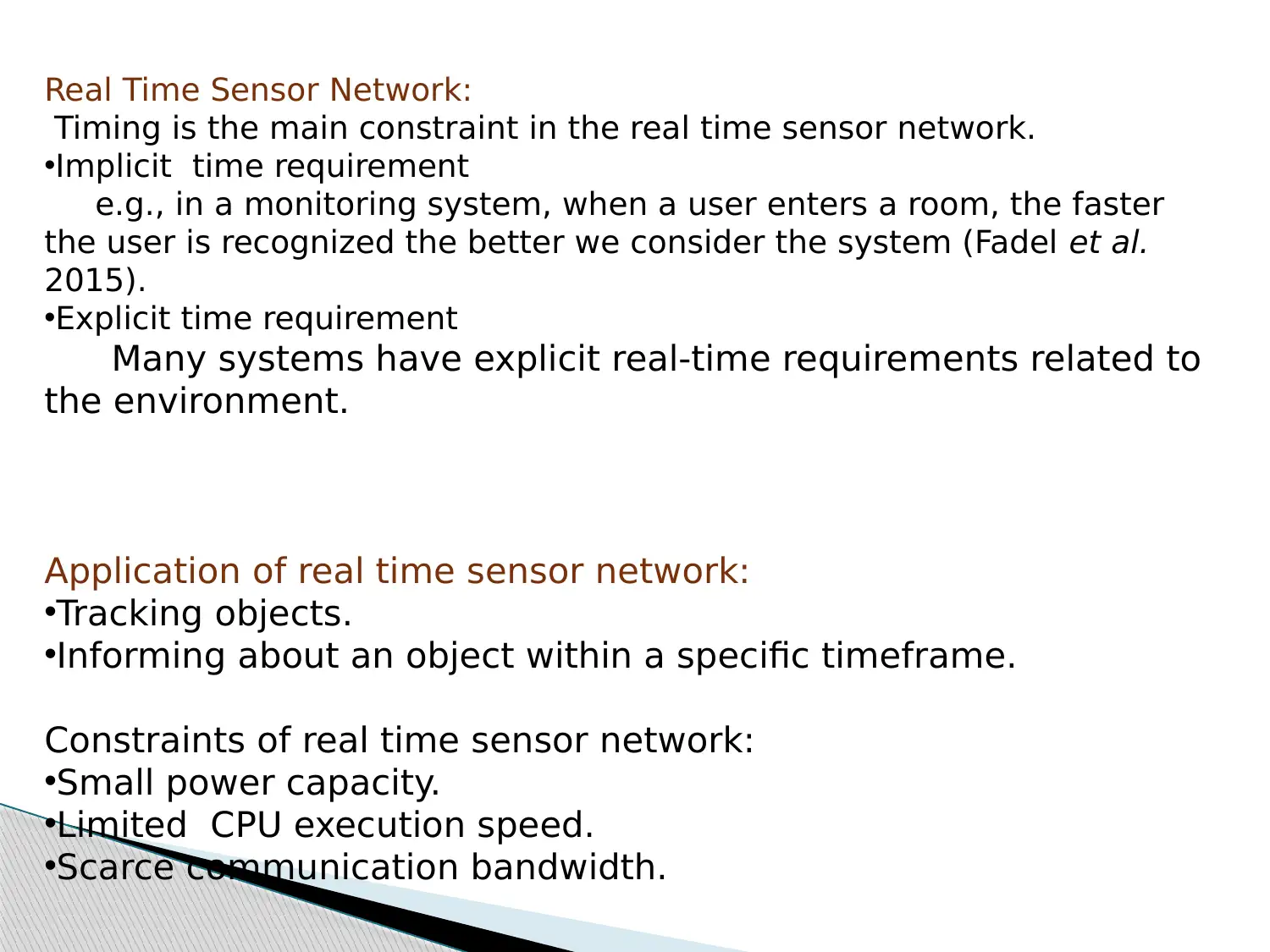
Real Time Sensor Network:
Timing is the main constraint in the real time sensor network.
•Implicit time requirement
e.g., in a monitoring system, when a user enters a room, the faster
the user is recognized the better we consider the system (Fadel et al.
2015).
•Explicit time requirement
Many systems have explicit real-time requirements related to
the environment.
Application of real time sensor network:
•Tracking objects.
•Informing about an object within a specific timeframe.
Constraints of real time sensor network:
•Small power capacity.
•Limited CPU execution speed.
•Scarce communication bandwidth.
Timing is the main constraint in the real time sensor network.
•Implicit time requirement
e.g., in a monitoring system, when a user enters a room, the faster
the user is recognized the better we consider the system (Fadel et al.
2015).
•Explicit time requirement
Many systems have explicit real-time requirements related to
the environment.
Application of real time sensor network:
•Tracking objects.
•Informing about an object within a specific timeframe.
Constraints of real time sensor network:
•Small power capacity.
•Limited CPU execution speed.
•Scarce communication bandwidth.
Secure Best Marks with AI Grader
Need help grading? Try our AI Grader for instant feedback on your assignments.
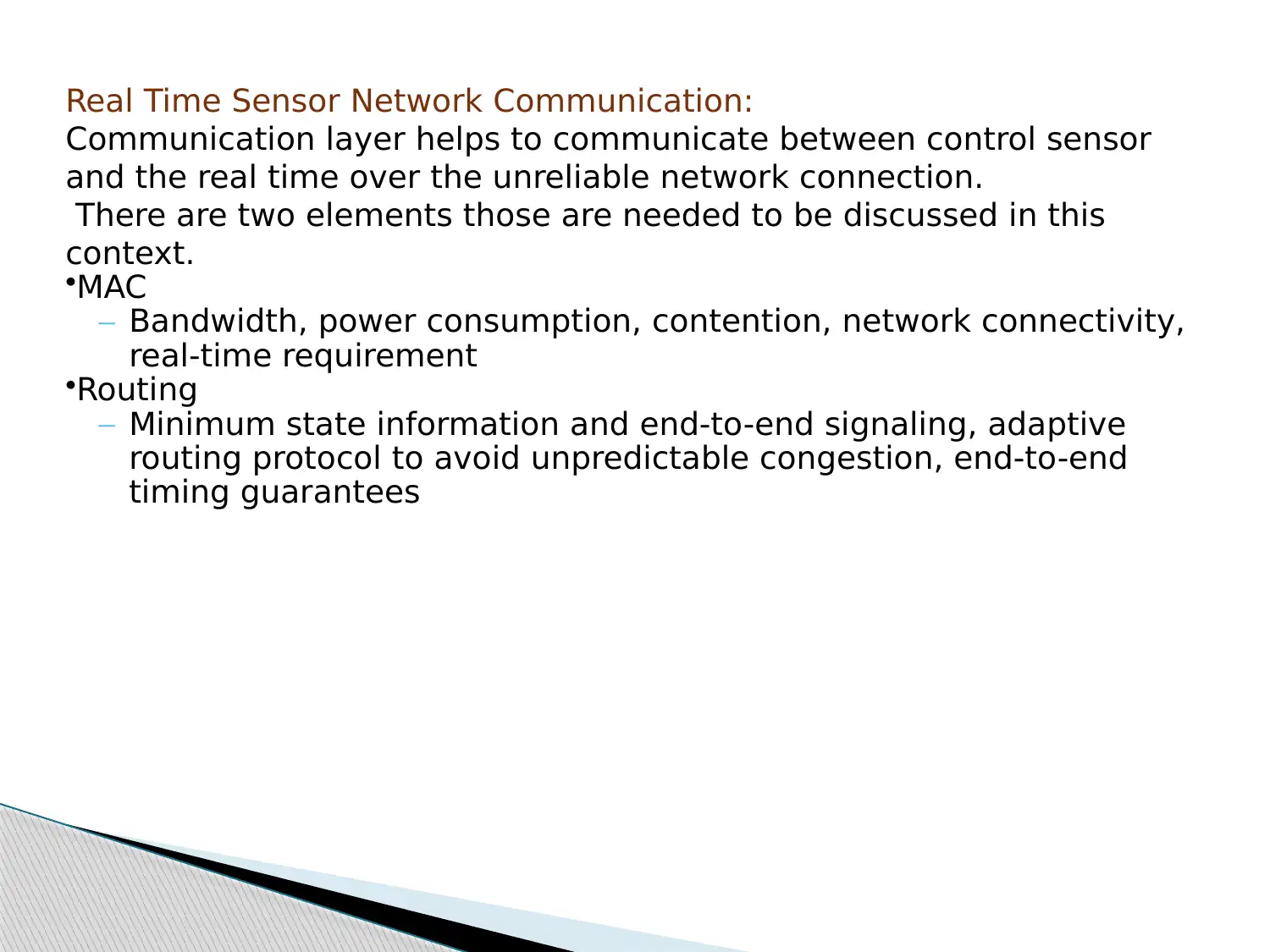
Real Time Sensor Network Communication:
Communication layer helps to communicate between control sensor
and the real time over the unreliable network connection.
There are two elements those are needed to be discussed in this
context.
•MAC
– Bandwidth, power consumption, contention, network connectivity,
real-time requirement
•Routing
– Minimum state information and end-to-end signaling, adaptive
routing protocol to avoid unpredictable congestion, end-to-end
timing guarantees
Communication layer helps to communicate between control sensor
and the real time over the unreliable network connection.
There are two elements those are needed to be discussed in this
context.
•MAC
– Bandwidth, power consumption, contention, network connectivity,
real-time requirement
•Routing
– Minimum state information and end-to-end signaling, adaptive
routing protocol to avoid unpredictable congestion, end-to-end
timing guarantees
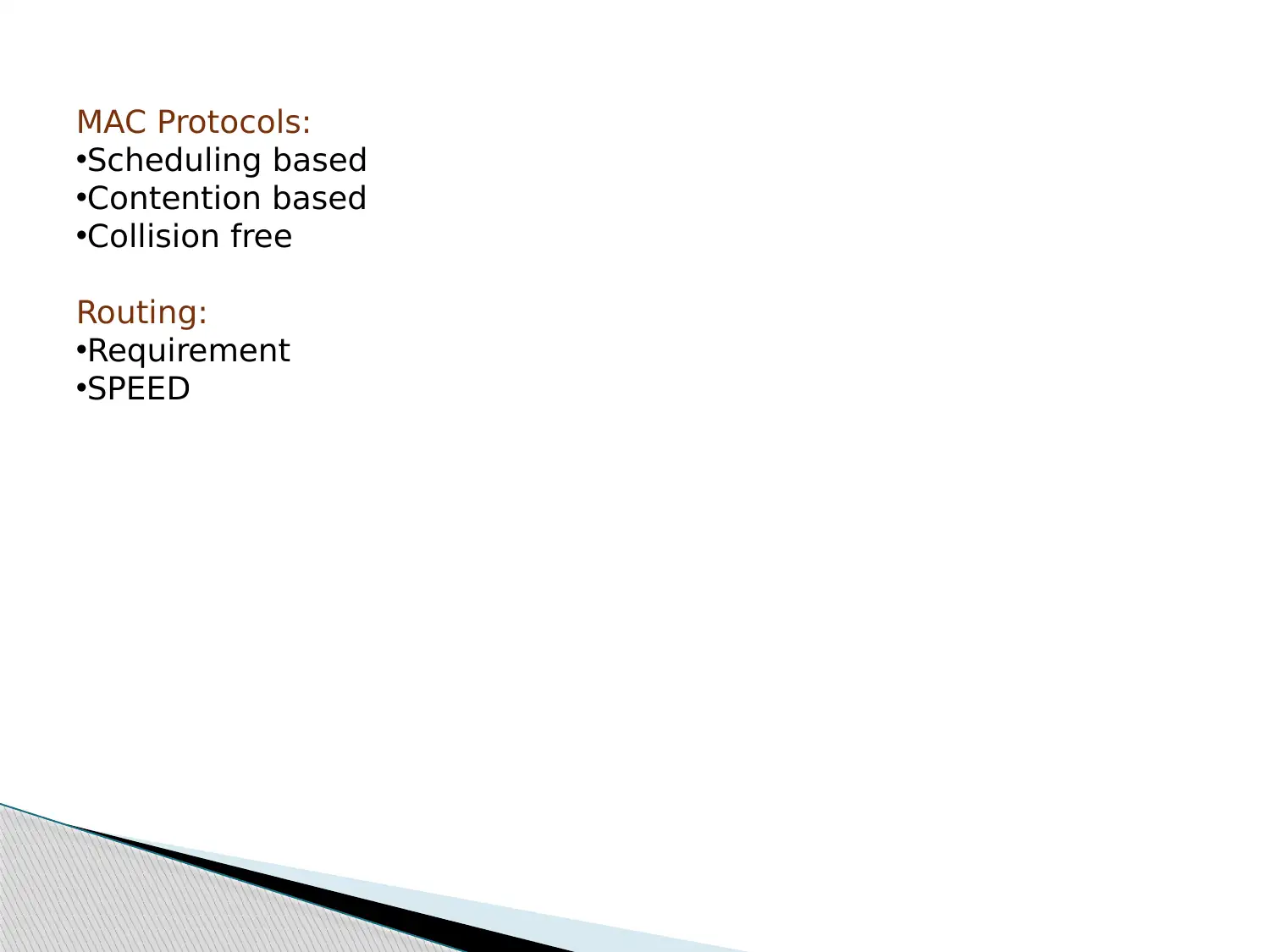
MAC Protocols:
•Scheduling based
•Contention based
•Collision free
Routing:
•Requirement
•SPEED
•Scheduling based
•Contention based
•Collision free
Routing:
•Requirement
•SPEED
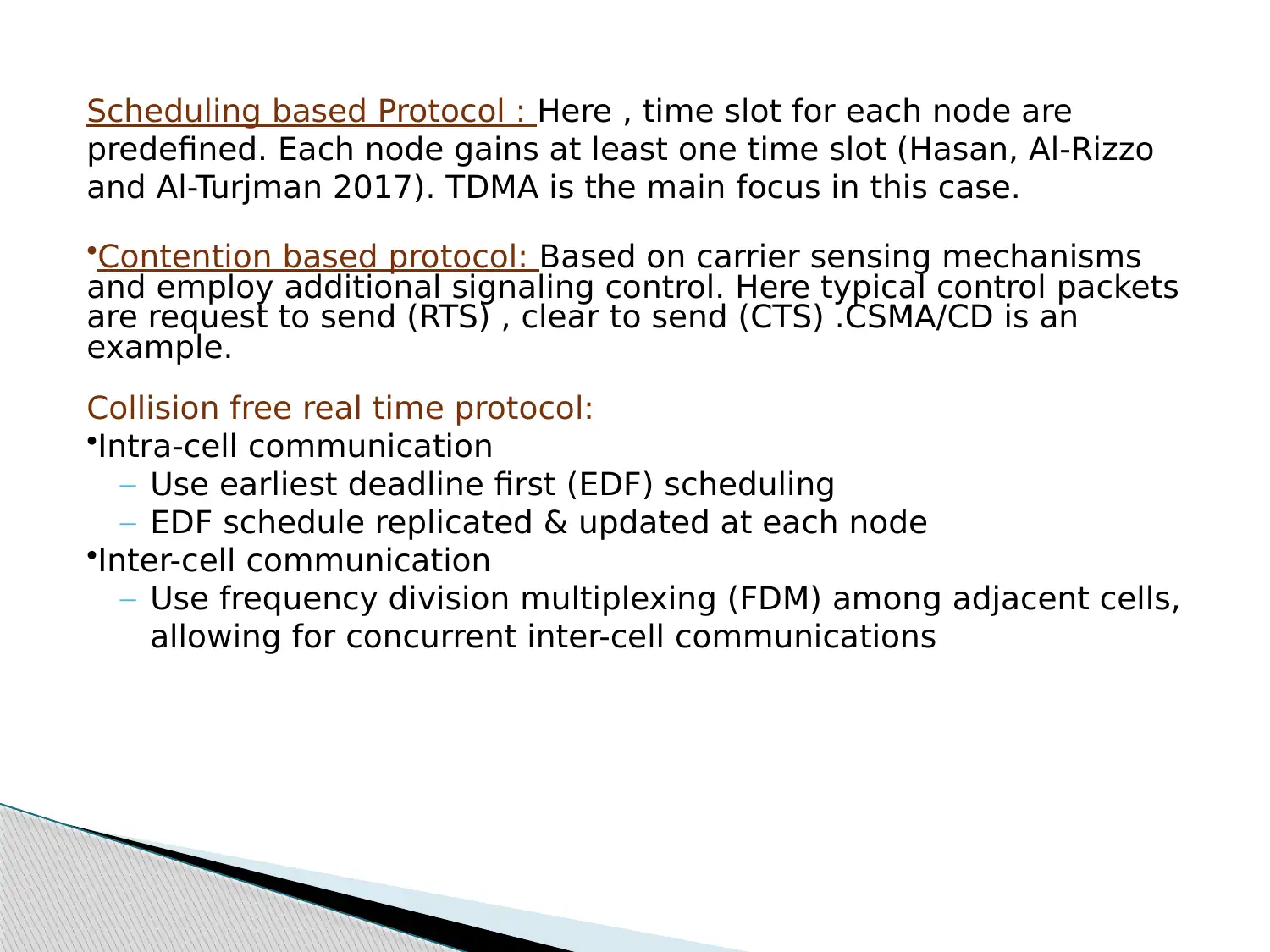
Scheduling based Protocol : Here , time slot for each node are
predefined. Each node gains at least one time slot (Hasan, Al-Rizzo
and Al-Turjman 2017). TDMA is the main focus in this case.
•Contention based protocol: Based on carrier sensing mechanisms
and employ additional signaling control. Here typical control packets
are request to send (RTS) , clear to send (CTS) .CSMA/CD is an
example.
Collision free real time protocol:
•Intra-cell communication
– Use earliest deadline first (EDF) scheduling
– EDF schedule replicated & updated at each node
•Inter-cell communication
– Use frequency division multiplexing (FDM) among adjacent cells,
allowing for concurrent inter-cell communications
predefined. Each node gains at least one time slot (Hasan, Al-Rizzo
and Al-Turjman 2017). TDMA is the main focus in this case.
•Contention based protocol: Based on carrier sensing mechanisms
and employ additional signaling control. Here typical control packets
are request to send (RTS) , clear to send (CTS) .CSMA/CD is an
example.
Collision free real time protocol:
•Intra-cell communication
– Use earliest deadline first (EDF) scheduling
– EDF schedule replicated & updated at each node
•Inter-cell communication
– Use frequency division multiplexing (FDM) among adjacent cells,
allowing for concurrent inter-cell communications
Paraphrase This Document
Need a fresh take? Get an instant paraphrase of this document with our AI Paraphraser
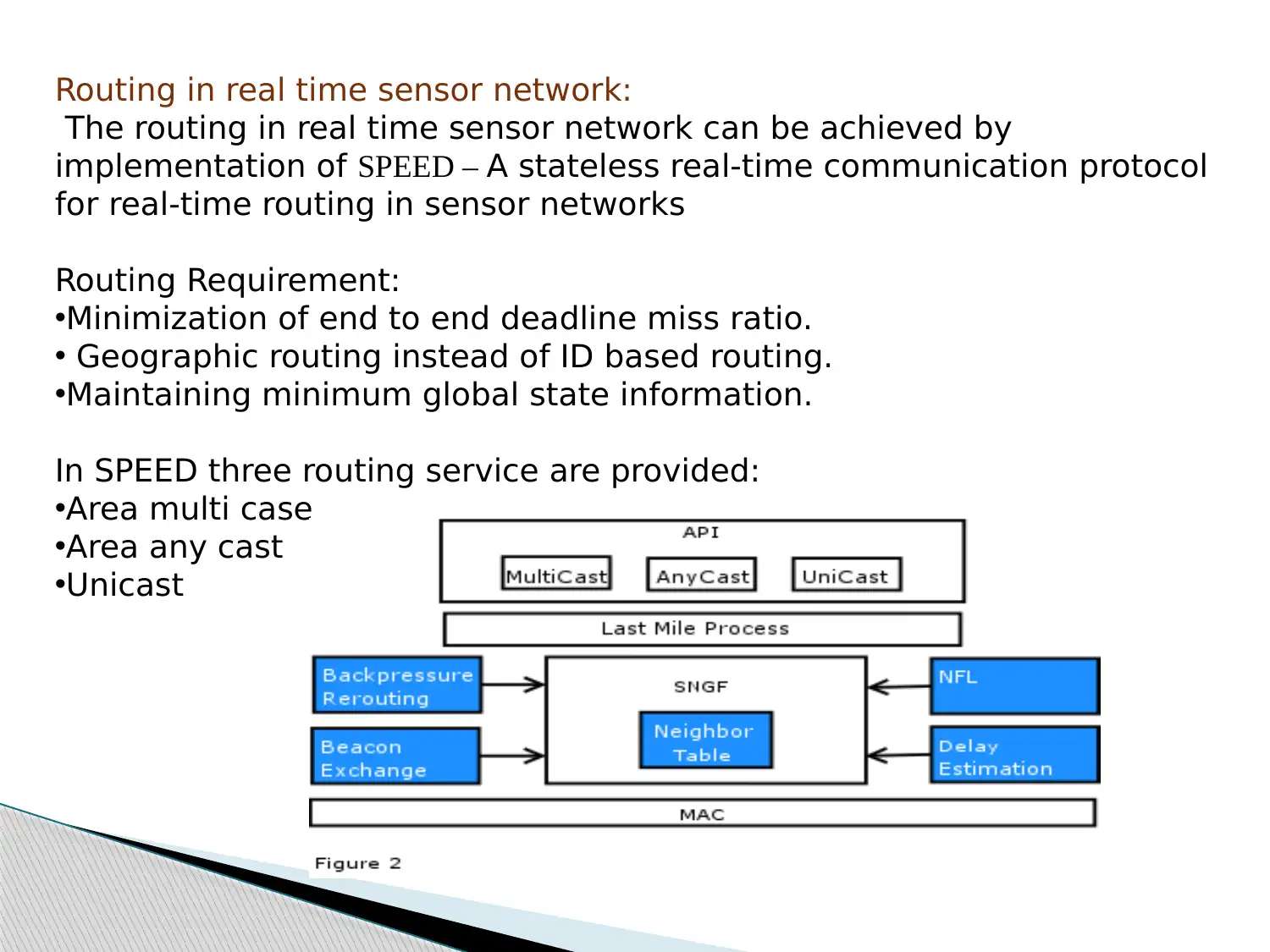
Routing in real time sensor network:
The routing in real time sensor network can be achieved by
implementation of SPEED – A stateless real-time communication protocol
for real-time routing in sensor networks
Routing Requirement:
•Minimization of end to end deadline miss ratio.
• Geographic routing instead of ID based routing.
•Maintaining minimum global state information.
In SPEED three routing service are provided:
•Area multi case
•Area any cast
•Unicast
The routing in real time sensor network can be achieved by
implementation of SPEED – A stateless real-time communication protocol
for real-time routing in sensor networks
Routing Requirement:
•Minimization of end to end deadline miss ratio.
• Geographic routing instead of ID based routing.
•Maintaining minimum global state information.
In SPEED three routing service are provided:
•Area multi case
•Area any cast
•Unicast
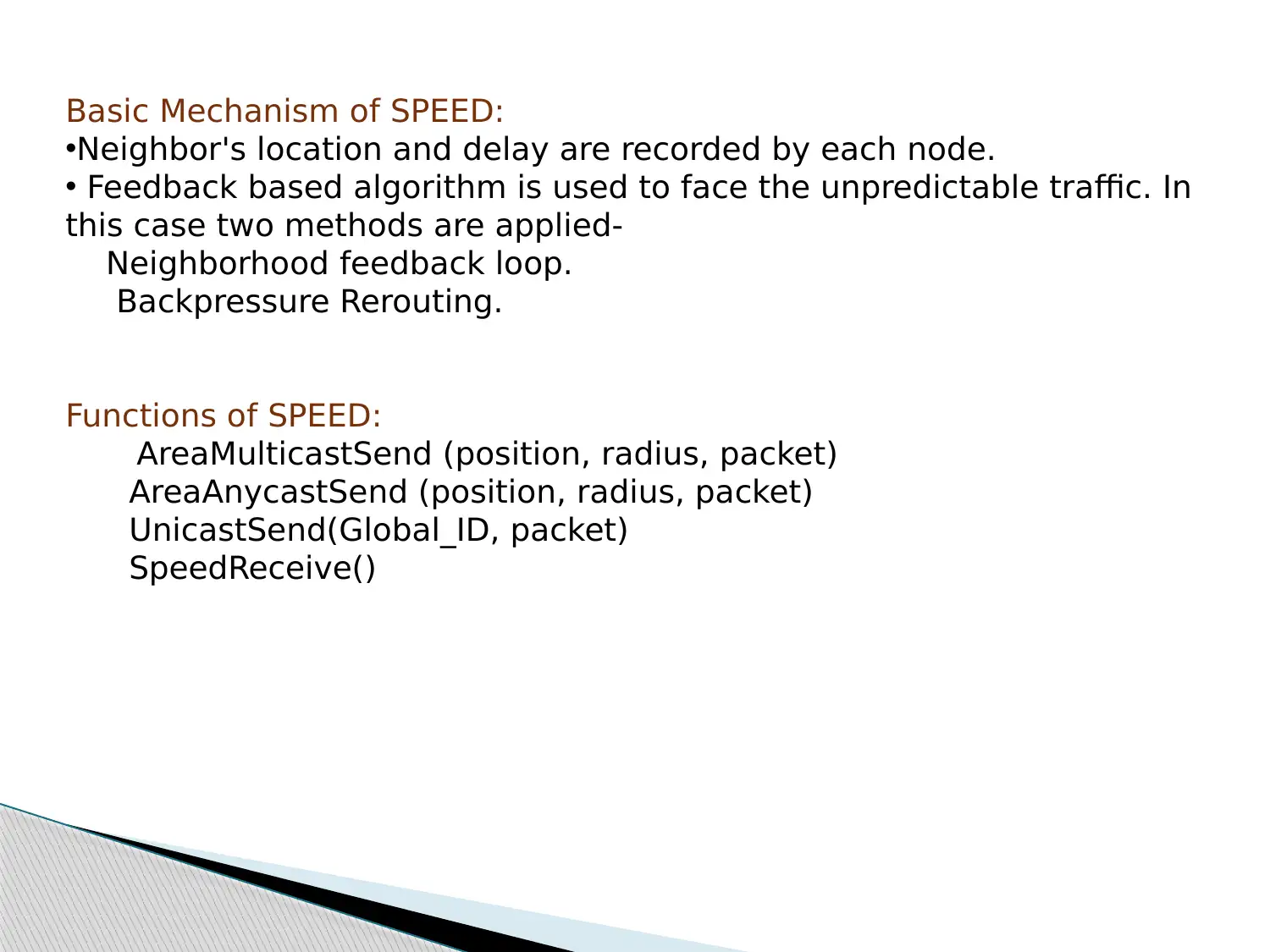
Basic Mechanism of SPEED:
•Neighbor's location and delay are recorded by each node.
• Feedback based algorithm is used to face the unpredictable traffic. In
this case two methods are applied-
Neighborhood feedback loop.
Backpressure Rerouting.
Functions of SPEED:
AreaMulticastSend (position, radius, packet)
AreaAnycastSend (position, radius, packet)
UnicastSend(Global_ID, packet)
SpeedReceive()
•Neighbor's location and delay are recorded by each node.
• Feedback based algorithm is used to face the unpredictable traffic. In
this case two methods are applied-
Neighborhood feedback loop.
Backpressure Rerouting.
Functions of SPEED:
AreaMulticastSend (position, radius, packet)
AreaAnycastSend (position, radius, packet)
UnicastSend(Global_ID, packet)
SpeedReceive()
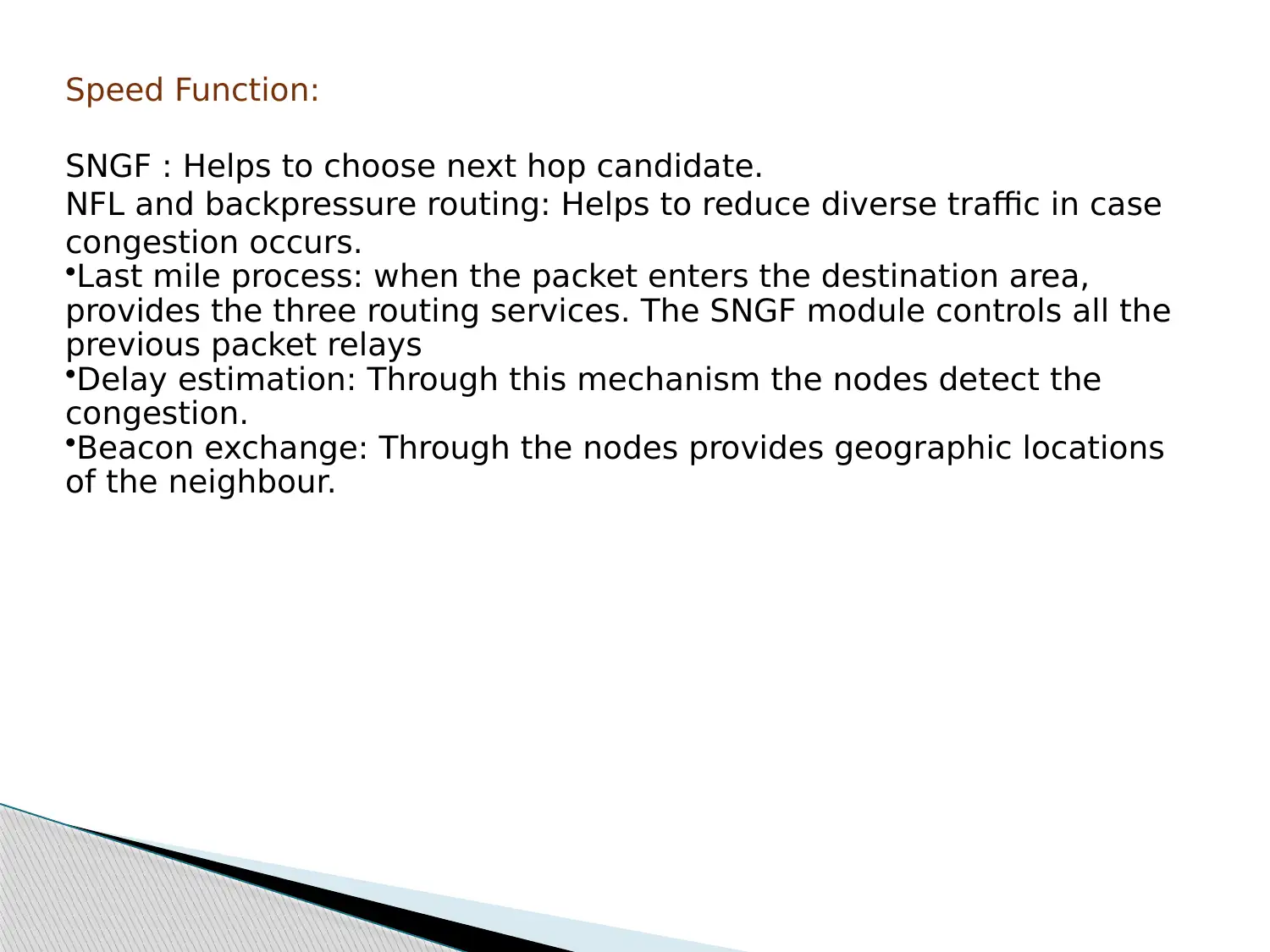
Speed Function:
SNGF : Helps to choose next hop candidate.
NFL and backpressure routing: Helps to reduce diverse traffic in case
congestion occurs.
•Last mile process: when the packet enters the destination area,
provides the three routing services. The SNGF module controls all the
previous packet relays
•Delay estimation: Through this mechanism the nodes detect the
congestion.
•Beacon exchange: Through the nodes provides geographic locations
of the neighbour.
SNGF : Helps to choose next hop candidate.
NFL and backpressure routing: Helps to reduce diverse traffic in case
congestion occurs.
•Last mile process: when the packet enters the destination area,
provides the three routing services. The SNGF module controls all the
previous packet relays
•Delay estimation: Through this mechanism the nodes detect the
congestion.
•Beacon exchange: Through the nodes provides geographic locations
of the neighbour.
Secure Best Marks with AI Grader
Need help grading? Try our AI Grader for instant feedback on your assignments.
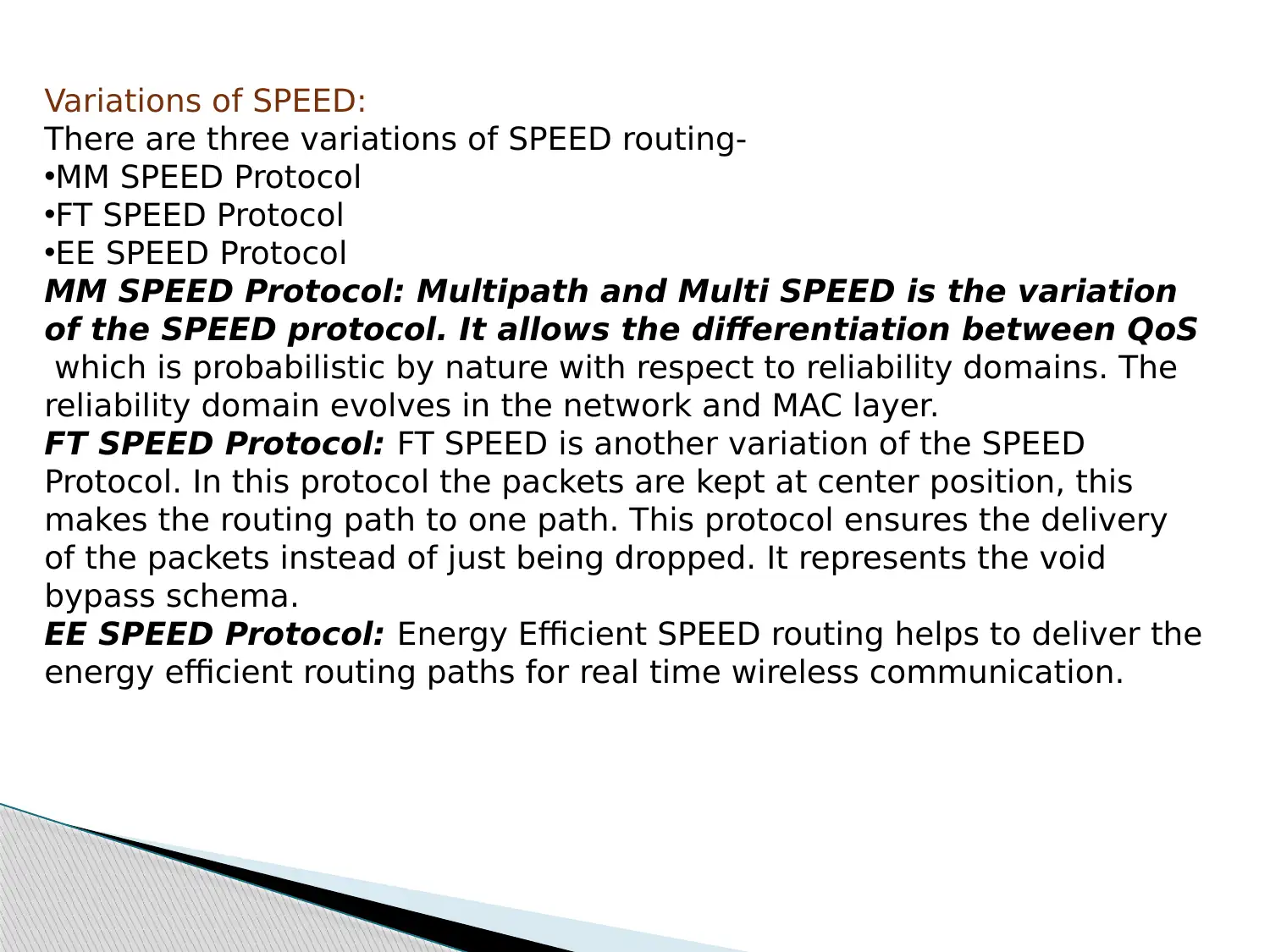
Variations of SPEED:
There are three variations of SPEED routing-
•MM SPEED Protocol
•FT SPEED Protocol
•EE SPEED Protocol
MM SPEED Protocol: Multipath and Multi SPEED is the variation
of the SPEED protocol. It allows the differentiation between QoS
which is probabilistic by nature with respect to reliability domains. The
reliability domain evolves in the network and MAC layer.
FT SPEED Protocol: FT SPEED is another variation of the SPEED
Protocol. In this protocol the packets are kept at center position, this
makes the routing path to one path. This protocol ensures the delivery
of the packets instead of just being dropped. It represents the void
bypass schema.
EE SPEED Protocol: Energy Efficient SPEED routing helps to deliver the
energy efficient routing paths for real time wireless communication.
There are three variations of SPEED routing-
•MM SPEED Protocol
•FT SPEED Protocol
•EE SPEED Protocol
MM SPEED Protocol: Multipath and Multi SPEED is the variation
of the SPEED protocol. It allows the differentiation between QoS
which is probabilistic by nature with respect to reliability domains. The
reliability domain evolves in the network and MAC layer.
FT SPEED Protocol: FT SPEED is another variation of the SPEED
Protocol. In this protocol the packets are kept at center position, this
makes the routing path to one path. This protocol ensures the delivery
of the packets instead of just being dropped. It represents the void
bypass schema.
EE SPEED Protocol: Energy Efficient SPEED routing helps to deliver the
energy efficient routing paths for real time wireless communication.
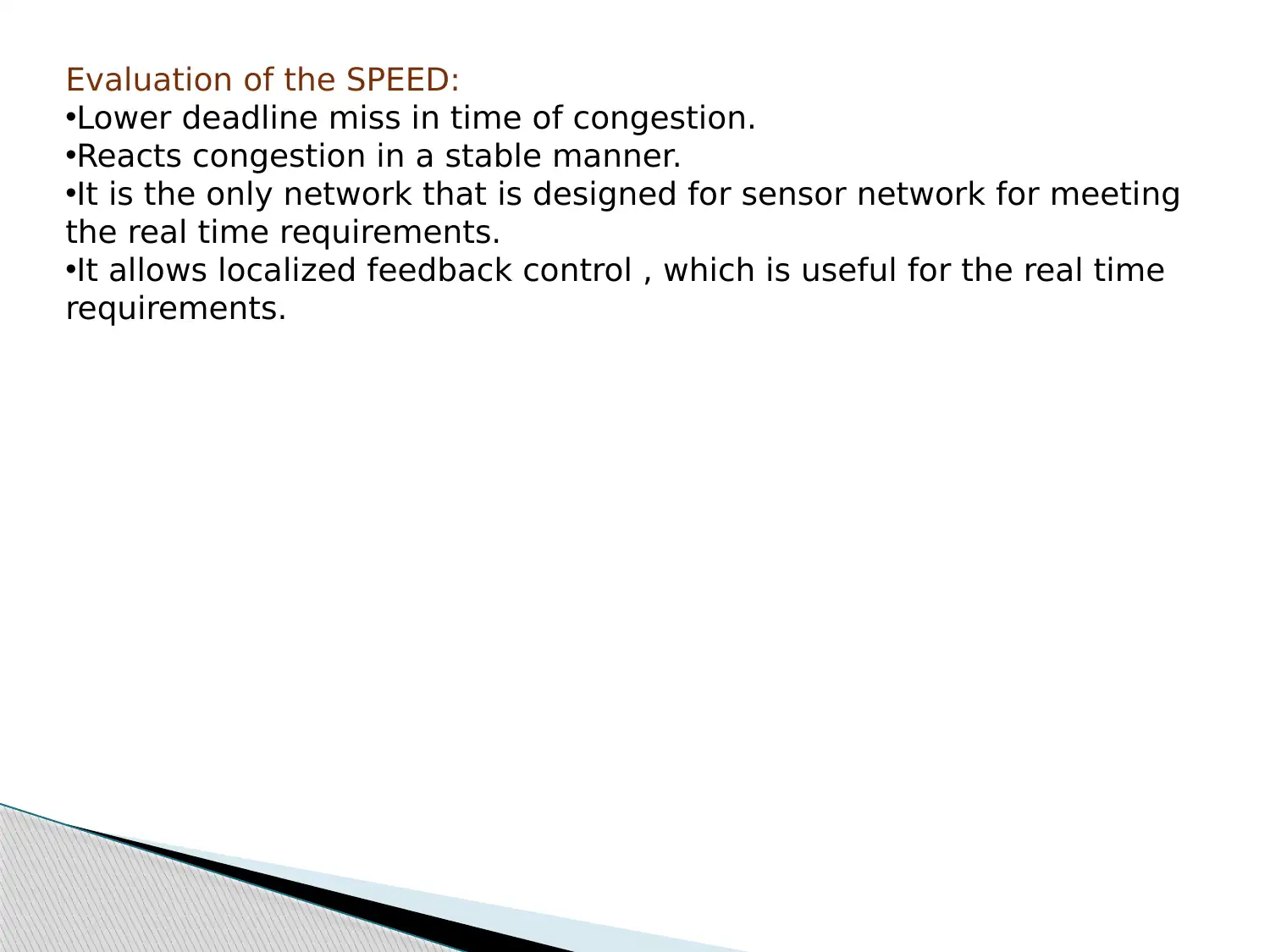
Evaluation of the SPEED:
•Lower deadline miss in time of congestion.
•Reacts congestion in a stable manner.
•It is the only network that is designed for sensor network for meeting
the real time requirements.
•It allows localized feedback control , which is useful for the real time
requirements.
•Lower deadline miss in time of congestion.
•Reacts congestion in a stable manner.
•It is the only network that is designed for sensor network for meeting
the real time requirements.
•It allows localized feedback control , which is useful for the real time
requirements.
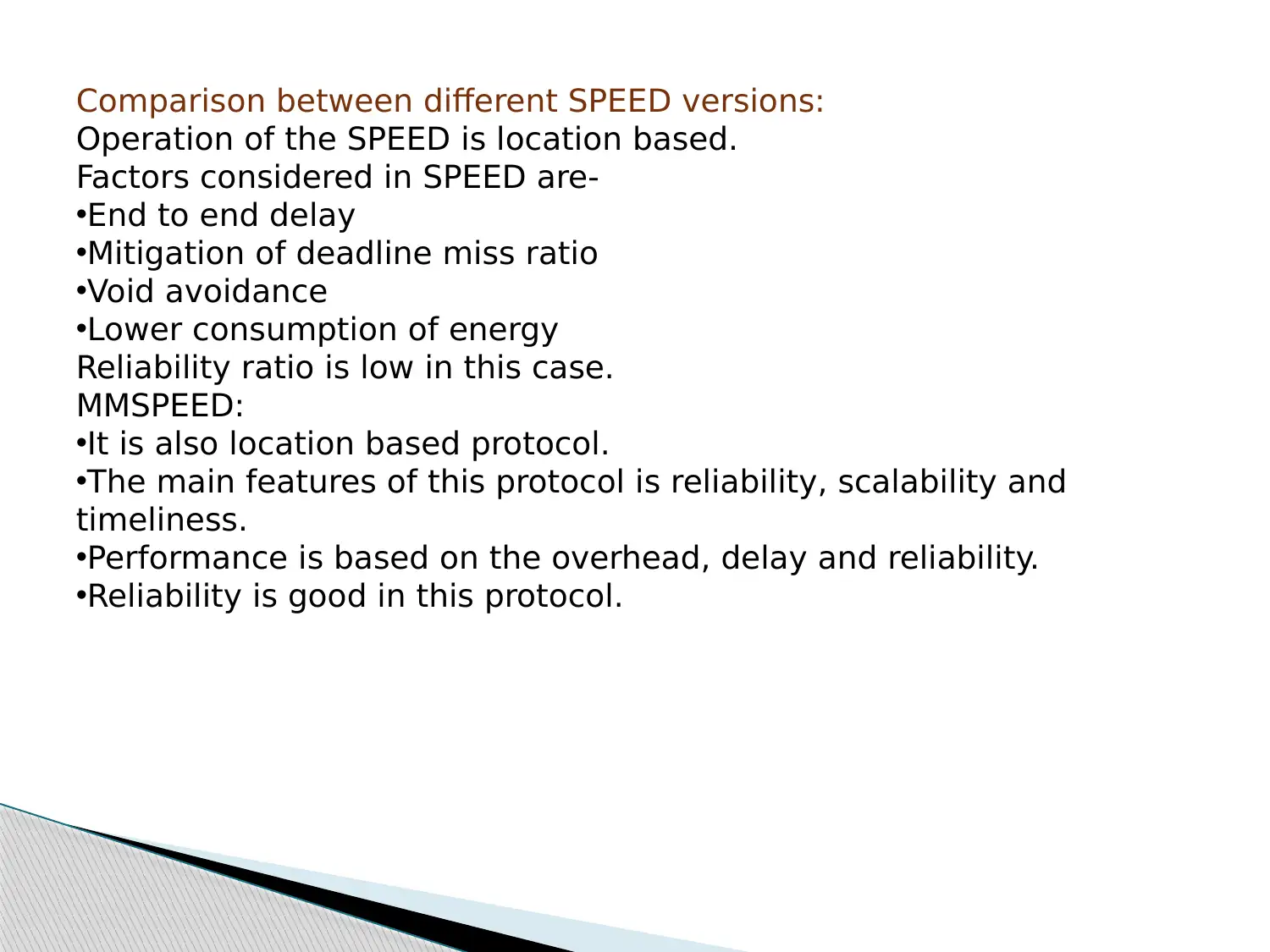
Comparison between different SPEED versions:
Operation of the SPEED is location based.
Factors considered in SPEED are-
•End to end delay
•Mitigation of deadline miss ratio
•Void avoidance
•Lower consumption of energy
Reliability ratio is low in this case.
MMSPEED:
•It is also location based protocol.
•The main features of this protocol is reliability, scalability and
timeliness.
•Performance is based on the overhead, delay and reliability.
•Reliability is good in this protocol.
Operation of the SPEED is location based.
Factors considered in SPEED are-
•End to end delay
•Mitigation of deadline miss ratio
•Void avoidance
•Lower consumption of energy
Reliability ratio is low in this case.
MMSPEED:
•It is also location based protocol.
•The main features of this protocol is reliability, scalability and
timeliness.
•Performance is based on the overhead, delay and reliability.
•Reliability is good in this protocol.
Paraphrase This Document
Need a fresh take? Get an instant paraphrase of this document with our AI Paraphraser
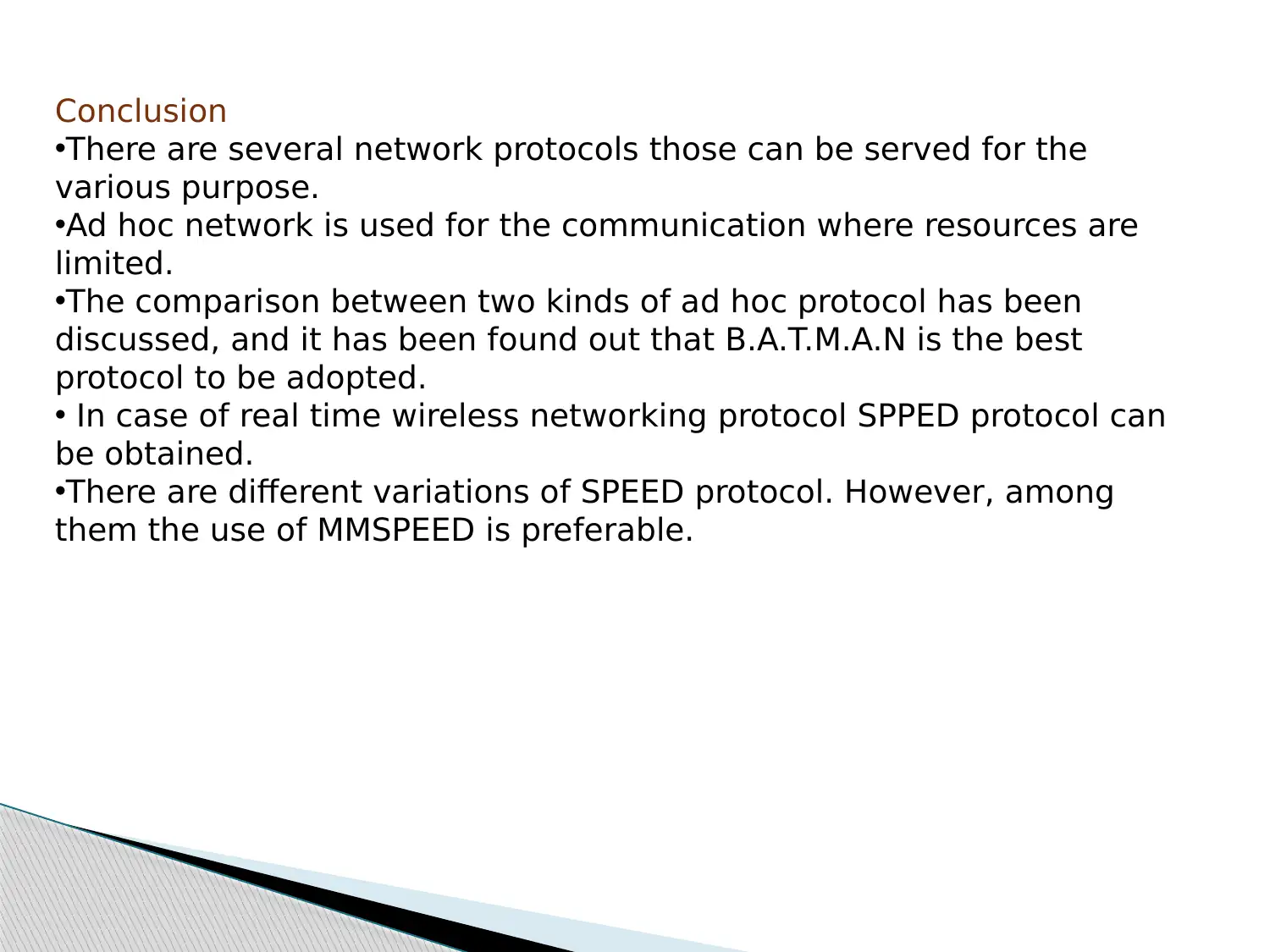
Conclusion
•There are several network protocols those can be served for the
various purpose.
•Ad hoc network is used for the communication where resources are
limited.
•The comparison between two kinds of ad hoc protocol has been
discussed, and it has been found out that B.A.T.M.A.N is the best
protocol to be adopted.
• In case of real time wireless networking protocol SPPED protocol can
be obtained.
•There are different variations of SPEED protocol. However, among
them the use of MMSPEED is preferable.
•There are several network protocols those can be served for the
various purpose.
•Ad hoc network is used for the communication where resources are
limited.
•The comparison between two kinds of ad hoc protocol has been
discussed, and it has been found out that B.A.T.M.A.N is the best
protocol to be adopted.
• In case of real time wireless networking protocol SPPED protocol can
be obtained.
•There are different variations of SPEED protocol. However, among
them the use of MMSPEED is preferable.
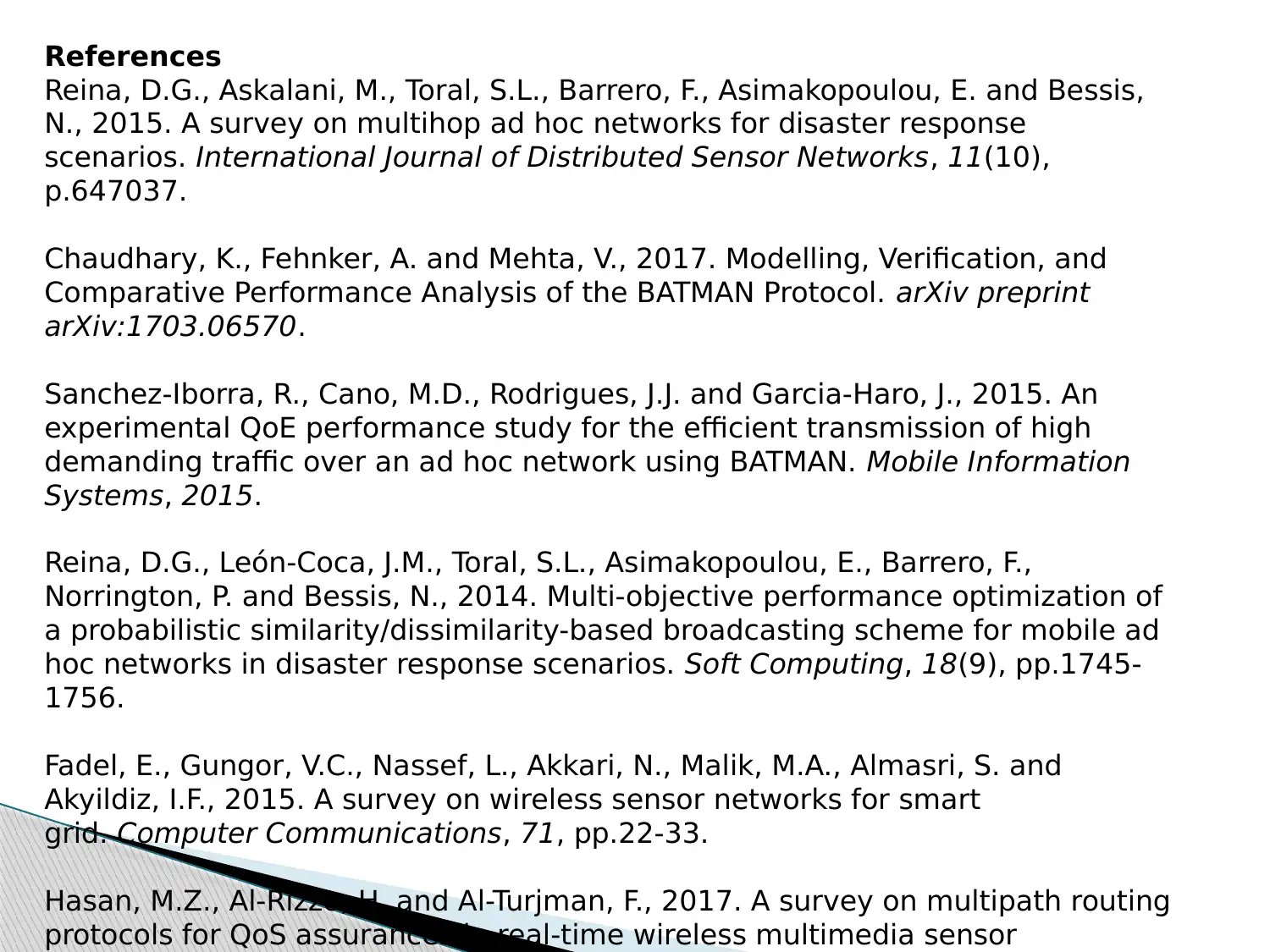
References
Reina, D.G., Askalani, M., Toral, S.L., Barrero, F., Asimakopoulou, E. and Bessis,
N., 2015. A survey on multihop ad hoc networks for disaster response
scenarios. International Journal of Distributed Sensor Networks, 11(10),
p.647037.
Chaudhary, K., Fehnker, A. and Mehta, V., 2017. Modelling, Verification, and
Comparative Performance Analysis of the BATMAN Protocol. arXiv preprint
arXiv:1703.06570.
Sanchez-Iborra, R., Cano, M.D., Rodrigues, J.J. and Garcia-Haro, J., 2015. An
experimental QoE performance study for the efficient transmission of high
demanding traffic over an ad hoc network using BATMAN. Mobile Information
Systems, 2015.
Reina, D.G., León-Coca, J.M., Toral, S.L., Asimakopoulou, E., Barrero, F.,
Norrington, P. and Bessis, N., 2014. Multi-objective performance optimization of
a probabilistic similarity/dissimilarity-based broadcasting scheme for mobile ad
hoc networks in disaster response scenarios. Soft Computing, 18(9), pp.1745-
1756.
Fadel, E., Gungor, V.C., Nassef, L., Akkari, N., Malik, M.A., Almasri, S. and
Akyildiz, I.F., 2015. A survey on wireless sensor networks for smart
grid. Computer Communications, 71, pp.22-33.
Hasan, M.Z., Al-Rizzo, H. and Al-Turjman, F., 2017. A survey on multipath routing
protocols for QoS assurances in real-time wireless multimedia sensor
Reina, D.G., Askalani, M., Toral, S.L., Barrero, F., Asimakopoulou, E. and Bessis,
N., 2015. A survey on multihop ad hoc networks for disaster response
scenarios. International Journal of Distributed Sensor Networks, 11(10),
p.647037.
Chaudhary, K., Fehnker, A. and Mehta, V., 2017. Modelling, Verification, and
Comparative Performance Analysis of the BATMAN Protocol. arXiv preprint
arXiv:1703.06570.
Sanchez-Iborra, R., Cano, M.D., Rodrigues, J.J. and Garcia-Haro, J., 2015. An
experimental QoE performance study for the efficient transmission of high
demanding traffic over an ad hoc network using BATMAN. Mobile Information
Systems, 2015.
Reina, D.G., León-Coca, J.M., Toral, S.L., Asimakopoulou, E., Barrero, F.,
Norrington, P. and Bessis, N., 2014. Multi-objective performance optimization of
a probabilistic similarity/dissimilarity-based broadcasting scheme for mobile ad
hoc networks in disaster response scenarios. Soft Computing, 18(9), pp.1745-
1756.
Fadel, E., Gungor, V.C., Nassef, L., Akkari, N., Malik, M.A., Almasri, S. and
Akyildiz, I.F., 2015. A survey on wireless sensor networks for smart
grid. Computer Communications, 71, pp.22-33.
Hasan, M.Z., Al-Rizzo, H. and Al-Turjman, F., 2017. A survey on multipath routing
protocols for QoS assurances in real-time wireless multimedia sensor
1 out of 27
Related Documents
Your All-in-One AI-Powered Toolkit for Academic Success.
+13062052269
info@desklib.com
Available 24*7 on WhatsApp / Email
![[object Object]](/_next/static/media/star-bottom.7253800d.svg)
Unlock your academic potential
© 2024 | Zucol Services PVT LTD | All rights reserved.





